Transforming your kitchen doesn't require a complete renovation when you master the art of painting kitchen cabinets. Whether you're seeking to modernize outdated wood tones, refresh worn surfaces, or completely reinvent your cooking space, strategic cabinet painting offers endless creative possibilities. Today's homeowners are embracing everything from timeless whites and sophisticated navy blues to bold earthtones and artistic techniques like distressing and ombre effects. The beauty of cabinet painting lies in its versatility—you can achieve professional-looking results while working within any budget. From choosing the right paint finish to mastering application techniques, each approach creates distinct atmospheres that reflect your personal style. With proper preparation and quality materials, painted cabinets deliver durability that withstands daily kitchen demands while providing the perfect backdrop for culinary creativity and family gatherings.
1. Classic White Cabinet Transformation
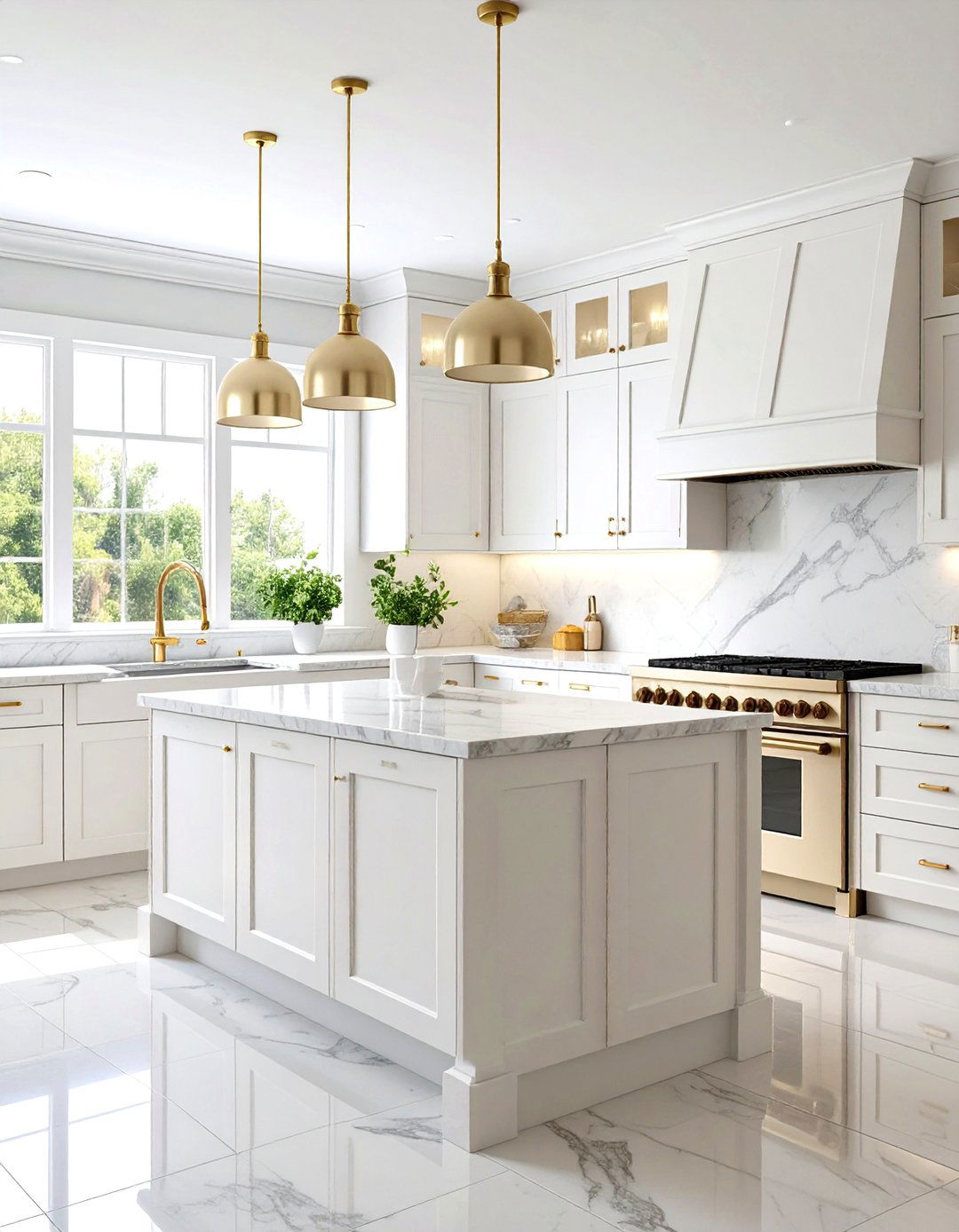
Are you dreaming of that perfect clean kitchen aesthetic that never goes out of style? Classic white cabinets remain the gold standard for kitchen design, offering endless versatility and timeless appeal. This foundational approach works beautifully with any countertop material, from marble to butcher block, while making smaller kitchens appear more spacious and bright. Choose between warm whites like Swiss Coffee for cozy appeal or crisp whites like Chantilly Lace for modern sophistication. The key lies in selecting quality paint with excellent coverage and durability. Pair white cabinets with colorful backsplashes, statement hardware, or bold wall colors to prevent the sterile look while maintaining that fresh, clean foundation.
2. Two-Tone Cabinet Design Strategy
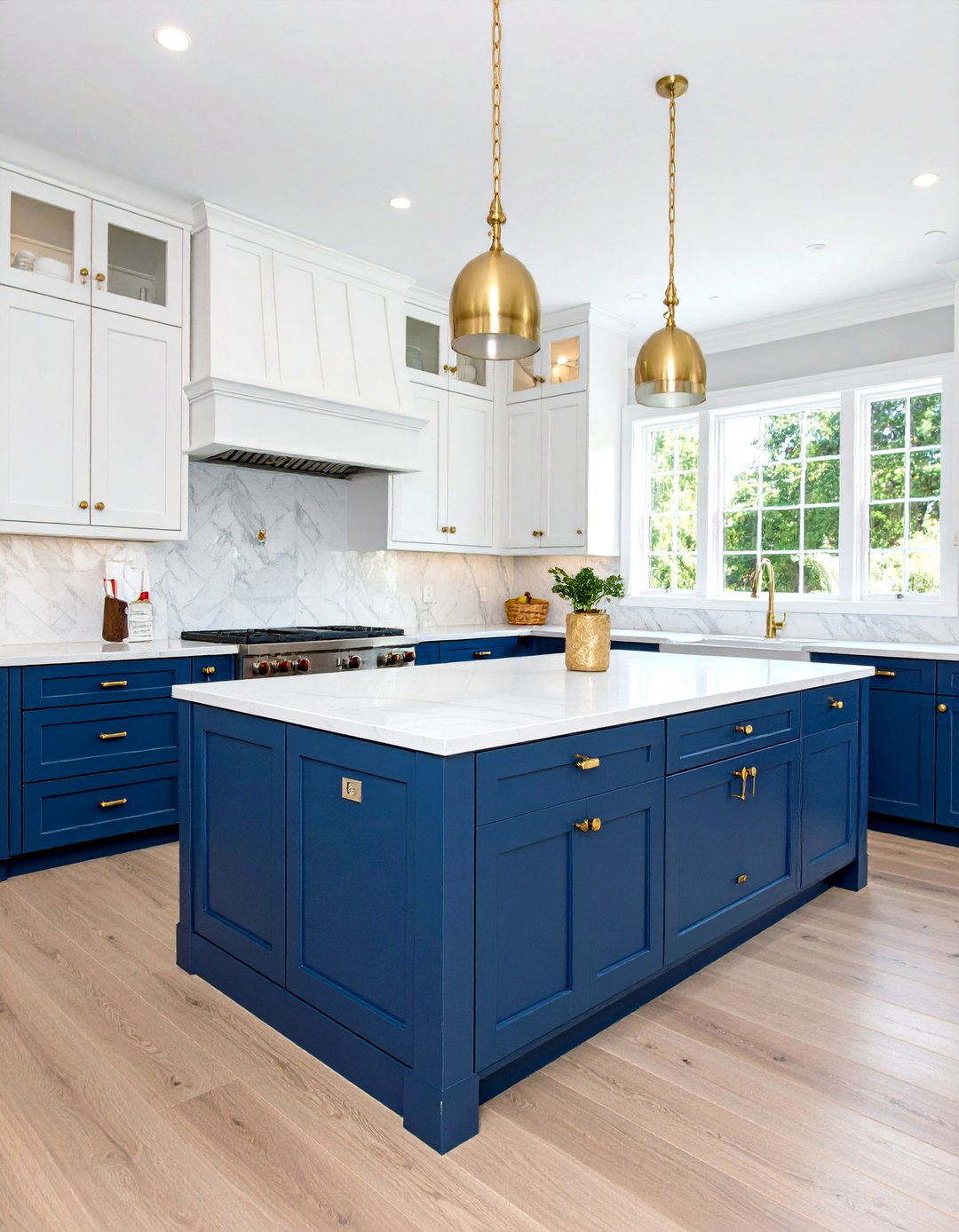
Why settle for one color when you can create visual drama with strategic two-tone combinations? This trending approach involves painting upper and lower cabinets in contrasting shades, instantly adding depth and sophistication to your kitchen design. Consider pairing light upper cabinets with darker lower ones to ground the space, or reverse this for an airy feel. Popular combinations include white uppers with navy lowers, sage green uppers with cream bases, or natural wood uppers with painted lower cabinets. This technique works especially well in open-concept homes where the kitchen flows into living areas. The contrast creates natural visual breaks while allowing you to incorporate multiple colors without overwhelming the space.
3. Bold Navy Blue Cabinet Elegance
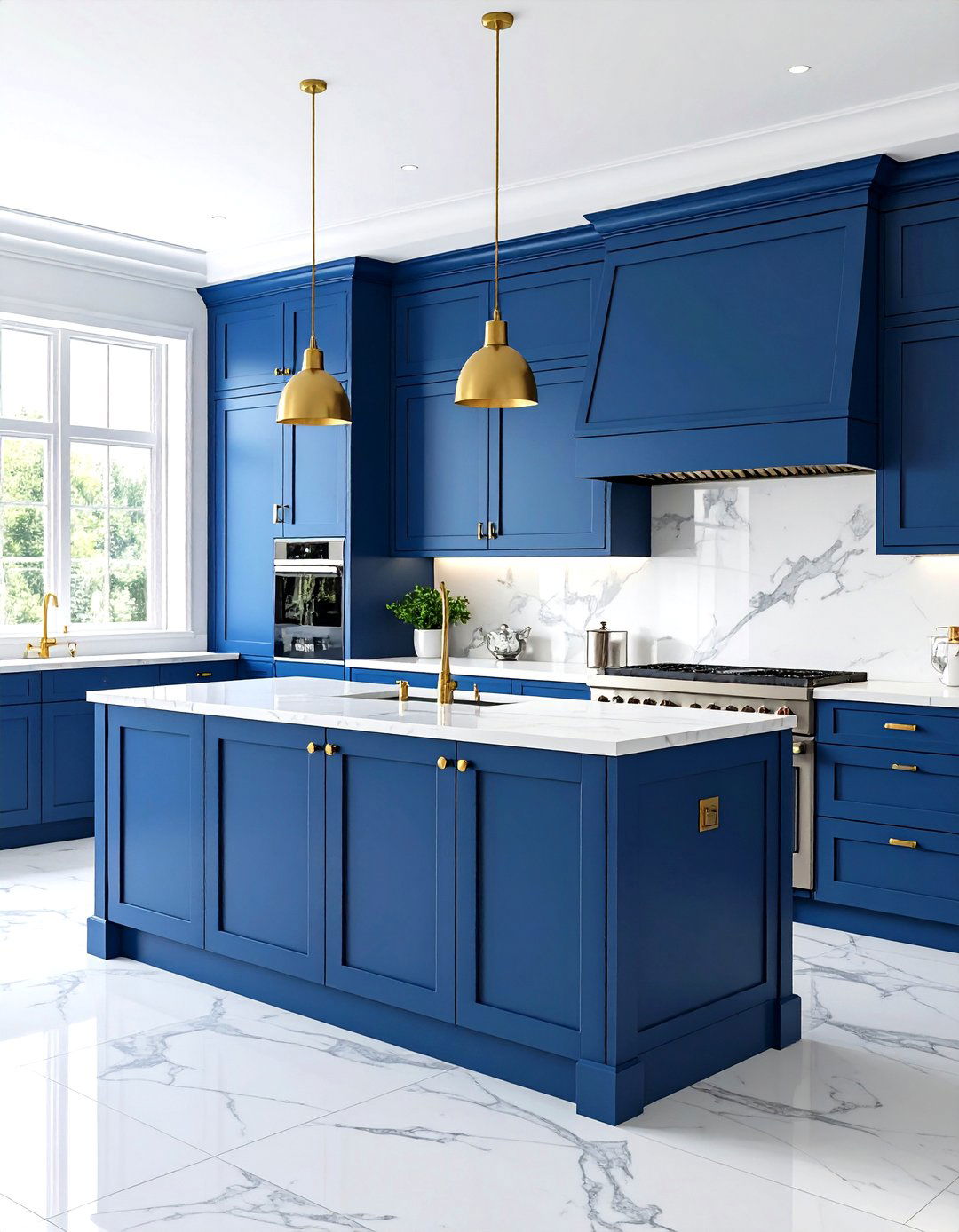
Could deep navy blue be the sophisticated alternative to black you've been searching for? Navy cabinets bring richness and depth while remaining surprisingly versatile across design styles. This classic color works beautifully in both traditional and contemporary kitchens, offering a timeless backdrop that won't feel dated in years to come. Navy pairs exceptionally well with brass hardware, white countertops, and warm wood accents. The key to success lies in balancing this bold choice with lighter elements—think white or light gray walls, plenty of natural light, and reflective surfaces. Consider this shade for kitchen islands to create stunning focal points without overwhelming smaller spaces.
4. Sage Green Natural Cabinet Appeal
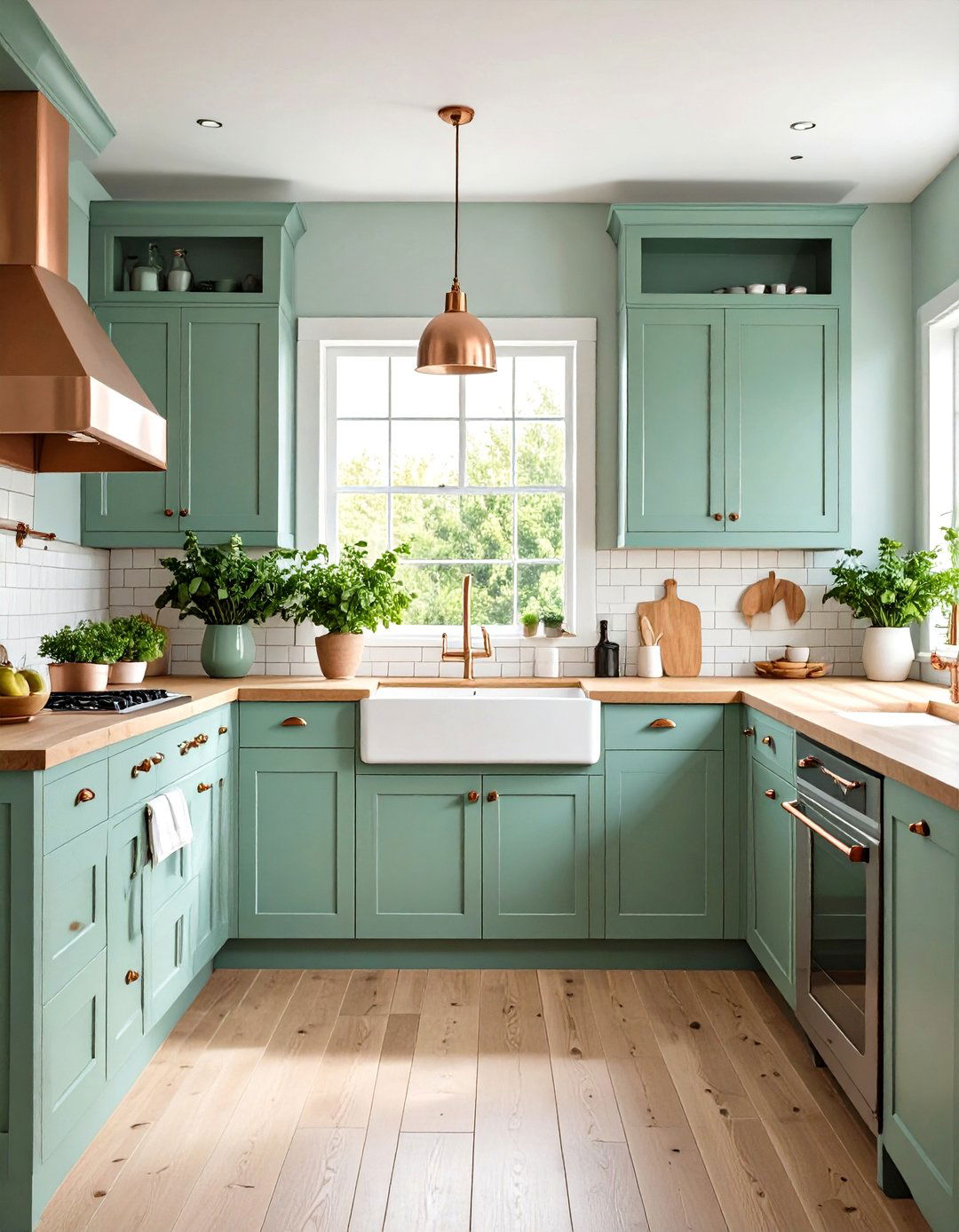
What if your kitchen could capture the serene feeling of a peaceful garden retreat? Sage green cabinets bring nature indoors while creating a calming atmosphere perfect for busy family kitchens. This versatile hue works beautifully with both warm and cool color palettes, complementing everything from warm wood tones to cool marble surfaces. Sage green pairs particularly well with white trim, natural stone countertops, and copper or brass hardware. The color's subtle sophistication makes it an excellent choice for homeowners wanting something more interesting than neutral tones but less dramatic than bold colors. This nature-inspired shade creates a spa-like atmosphere that promotes relaxation.
5. Charcoal Gray Modern Cabinet Sophistication
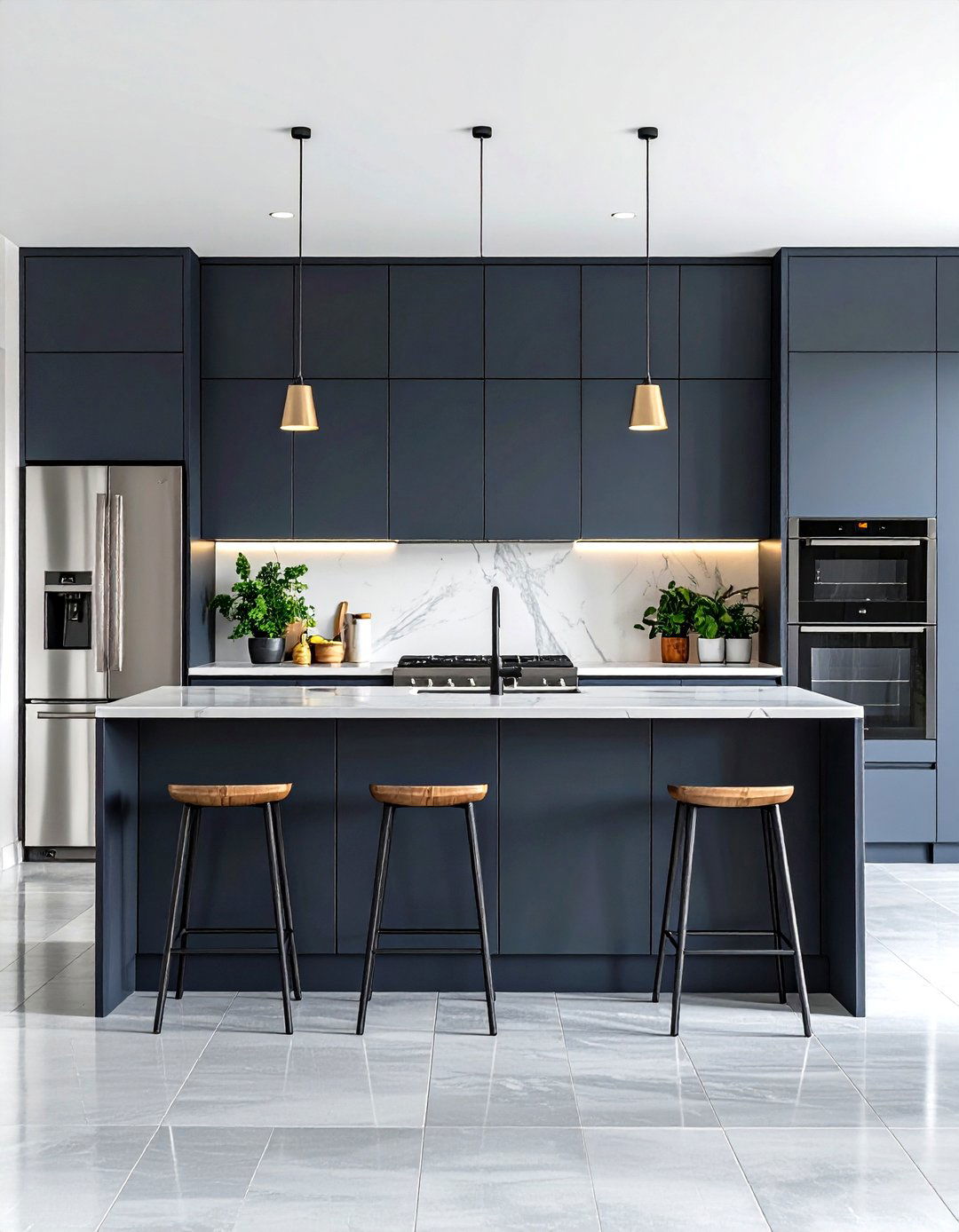
Have you considered the dramatic elegance that charcoal gray cabinets can bring to contemporary kitchen design? This sophisticated shade offers the boldness of black with more versatility and warmth. Charcoal works beautifully in modern and transitional kitchens, providing a sleek backdrop for stainless steel appliances and minimalist hardware. The color's neutral base allows for creative accent choices—bright backsplashes, colorful art, or natural wood elements all pop against this rich foundation. Balance charcoal cabinets with light countertops and walls to prevent the space from feeling too dark. This color choice creates kitchens that feel both current and timelessly elegant.
6. Distressed Farmhouse Cabinet Character
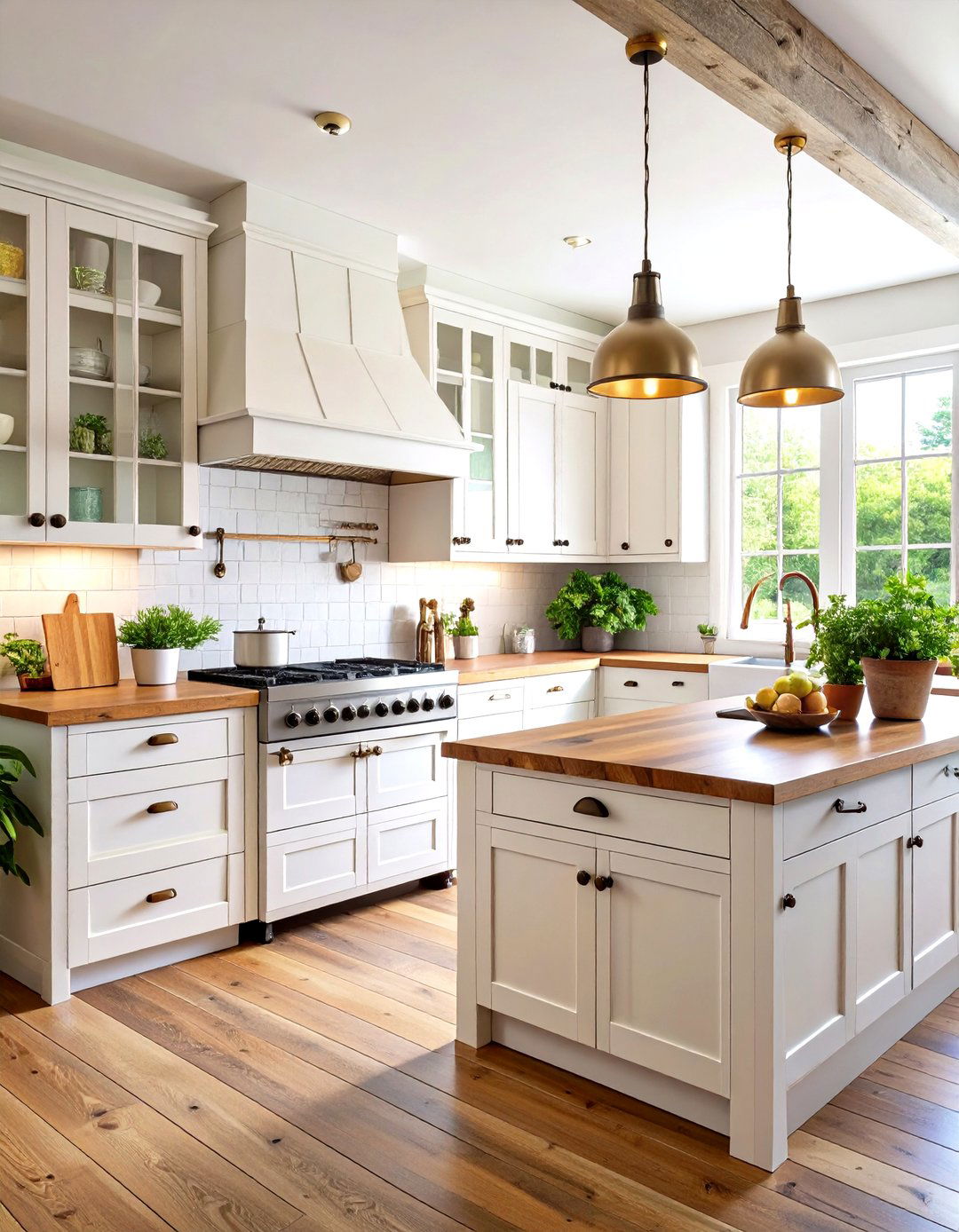
Do you love the authentic charm of well-loved vintage pieces? Distressed cabinet finishes create that perfect farmhouse appeal by intentionally aging new or existing cabinets. This technique involves strategic sanding, glazing, and sometimes physical distressing to achieve an authentic weathered appearance. Start with a base coat, then sand edges and high-wear areas before applying darker glaze to enhance the aged effect. Popular color combinations include white base with gray or brown glaze, or cream with darker antiquing effects. The beauty of distressed finishes lies in their imperfection—small flaws and variations actually enhance the authentic vintage appeal. This approach works particularly well in country, cottage, and rustic kitchen designs.
7. High-Gloss Finish Cabinet Glamour
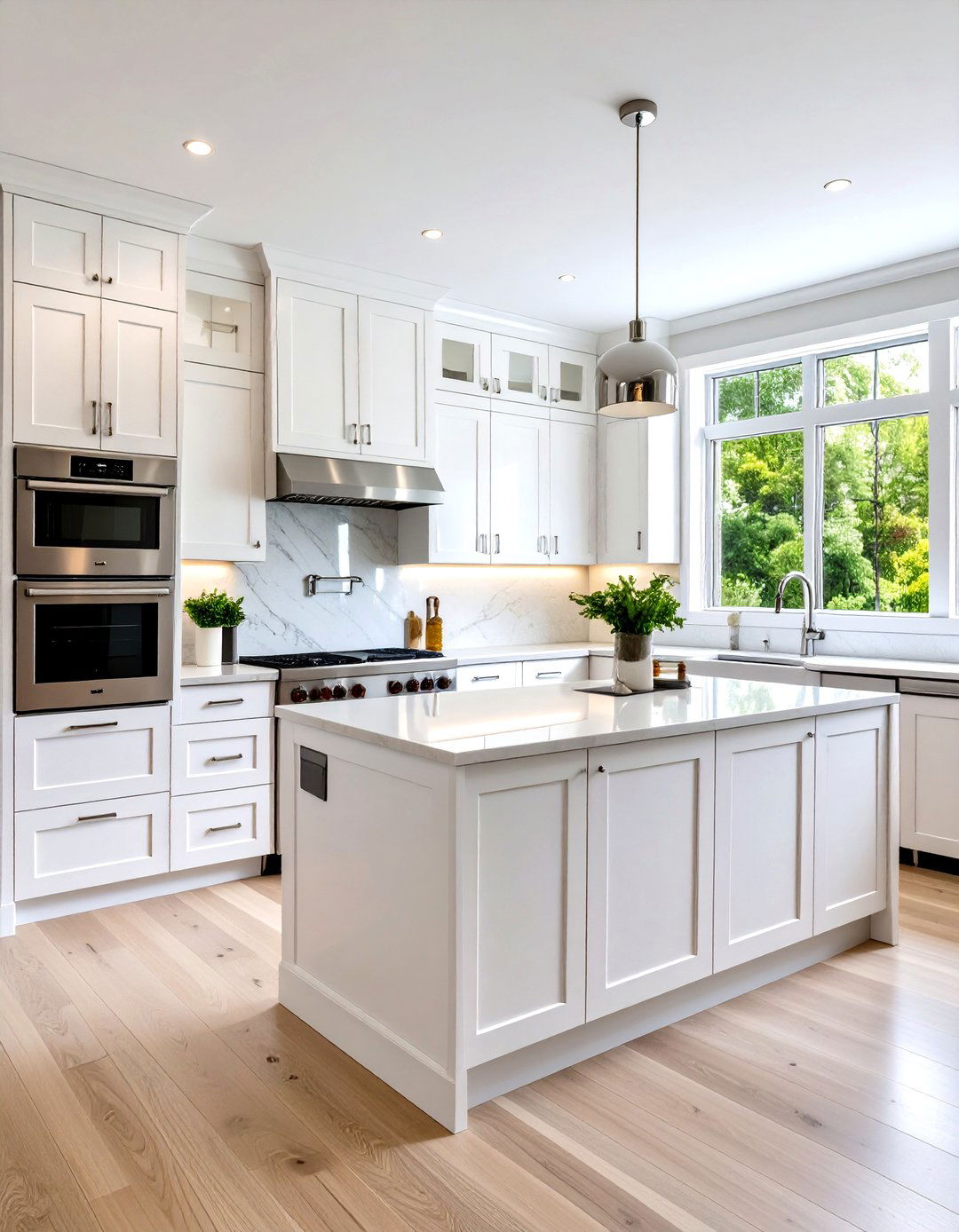
Are you ready to embrace the sleek sophistication of high-gloss cabinet finishes? This luxurious approach creates mirror-like surfaces that reflect light and make kitchens appear larger and more luminous. High-gloss finishes work particularly well in modern and contemporary designs, creating that coveted "designer kitchen" appearance. While this finish shows fingerprints more readily than matte alternatives, its easy-clean surface makes maintenance manageable with regular wiping. The key to success lies in meticulous surface preparation—any imperfections will be magnified by the glossy finish. Consider high-gloss for kitchen islands or select cabinets to add glamour without overwhelming the entire space. This finish pairs beautifully with minimalist hardware and clean lines.
8. Matte Finish Cabinet Contemporary Style
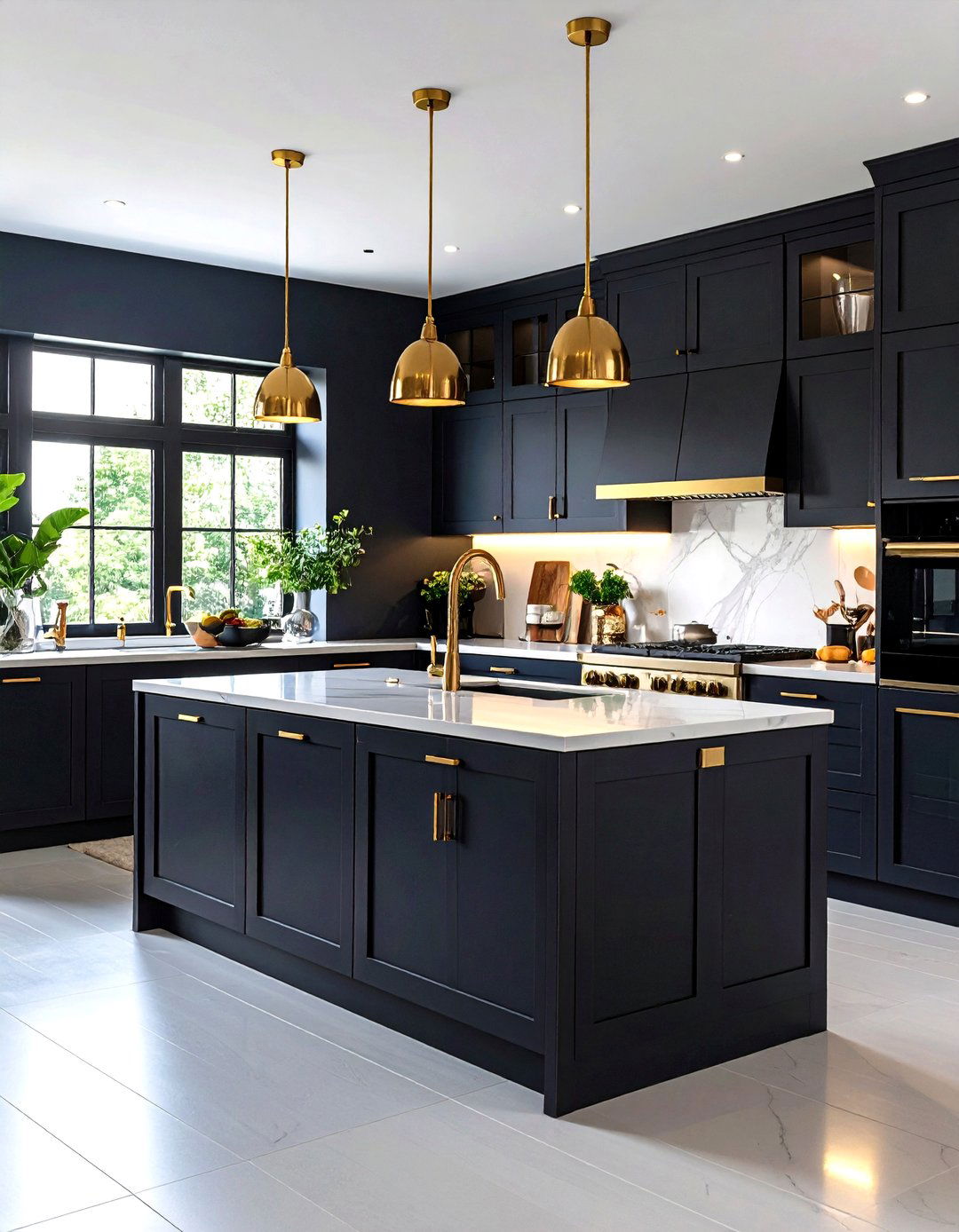
Why is matte paint becoming the sophisticated choice for discerning homeowners? Matte finishes offer elegant, velvety surfaces that hide imperfections while creating depth and richness impossible to achieve with glossy alternatives. This contemporary approach works beautifully across color palettes, from dramatic blacks to soft pastels. Matte surfaces don't reflect light harshly, creating cozy, intimate atmospheres perfect for family gatherings. While slightly more challenging to clean than semi-gloss alternatives, quality matte paints now offer improved durability and washability. The sophisticated appearance justifies the extra care required. Matte finishes work particularly well in traditional, transitional, and modern farmhouse kitchens where texture and warmth matter more than high-shine glamour.
9. Antiqued Glaze Technique Mastery
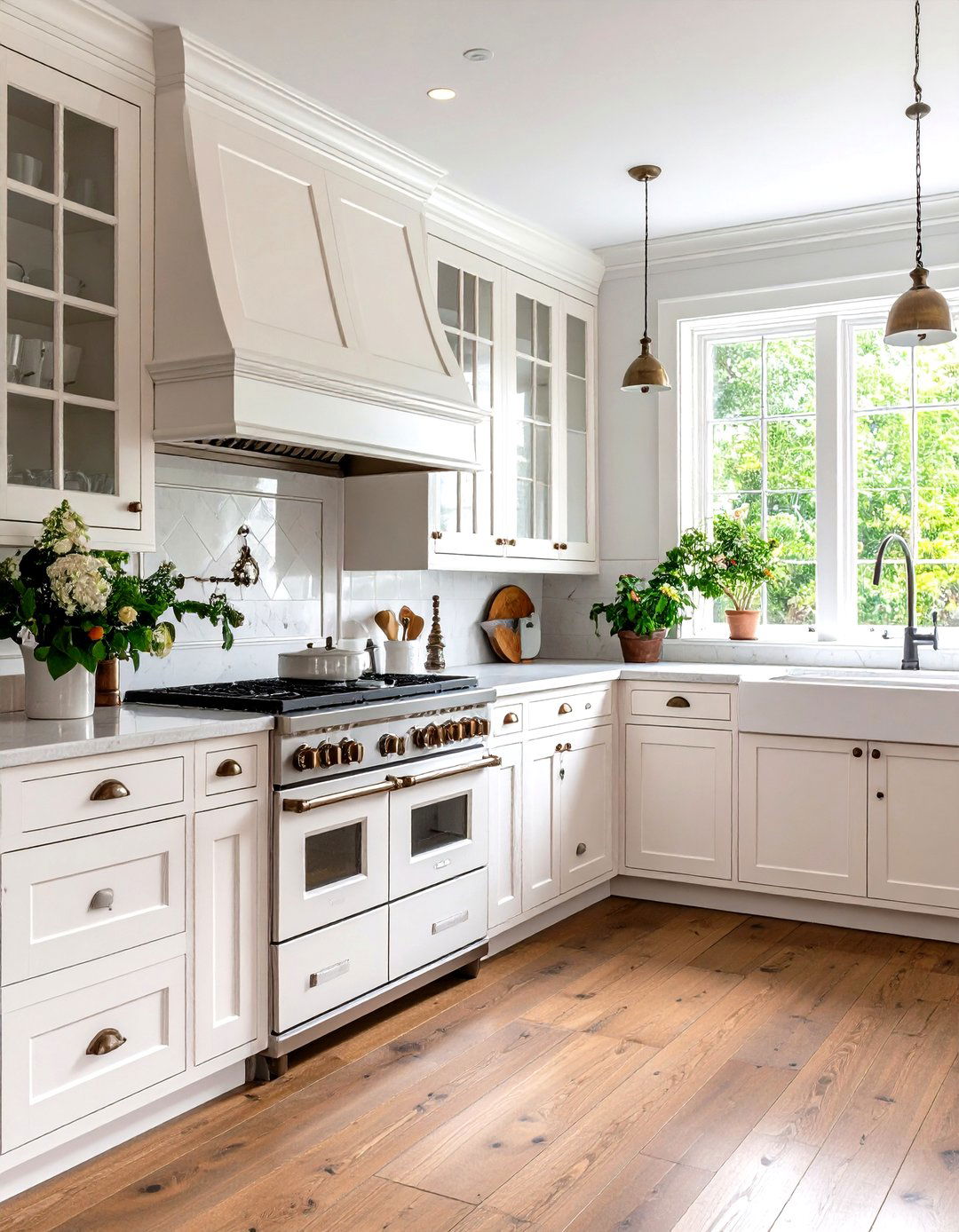
What transforms ordinary painted cabinets into furniture-quality masterpieces? Antiqued glazing techniques add depth, character, and professional polish to cabinet painting projects. This process involves applying translucent glaze over dried base paint, then manipulating it with rags, brushes, or sponges to create aged effects. Popular glaze colors include umber for warm brown tones, raw sienna for golden effects, or gray for cooler antiquing. The technique works beautifully over white, cream, or light-colored base paints. Apply glaze sparingly—you can always add more, but removing excess requires careful work. Focus glazing in natural wear areas like edges, corners, and around hardware for authentic aging effects. This professional technique elevates DIY projects significantly.
10. Ombre Gradient Cabinet Artistry
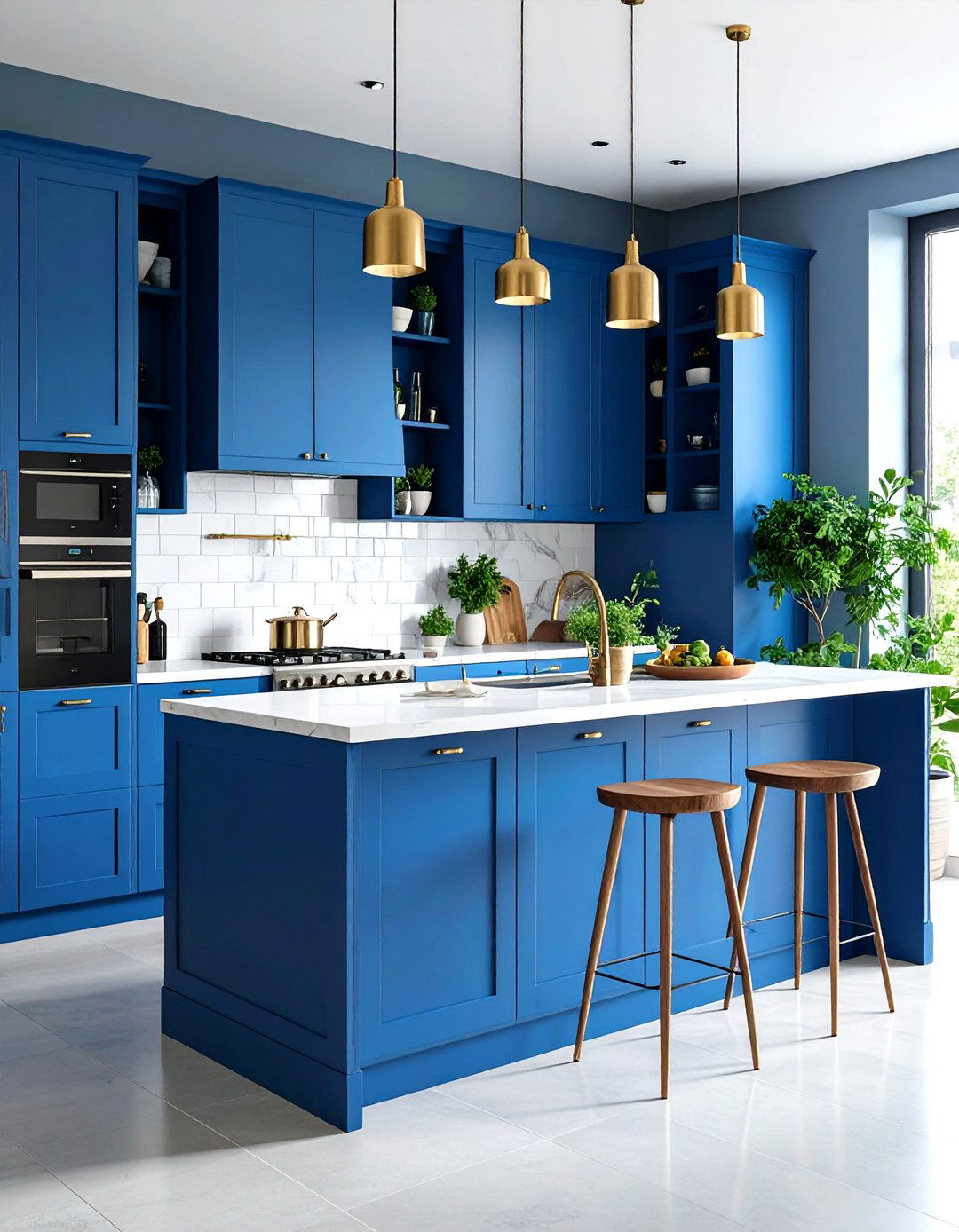
Could your kitchen cabinets become stunning works of functional art? Ombre painting techniques create beautiful color gradations that transform cabinets into conversation pieces. This artistic approach works particularly well on tall cabinet banks or kitchen islands where the gradient effect can be fully appreciated. Start with your lightest shade at the top, gradually blending to deeper tones toward the bottom. Popular color families include blues from sky to navy, greens from sage to forest, or neutrals from cream to charcoal. Success requires careful color mixing and blending skills, but the dramatic results justify the effort. This technique works best in contemporary or eclectic kitchen designs where artistic elements are appreciated.
11. Chalk Paint Method Simplicity
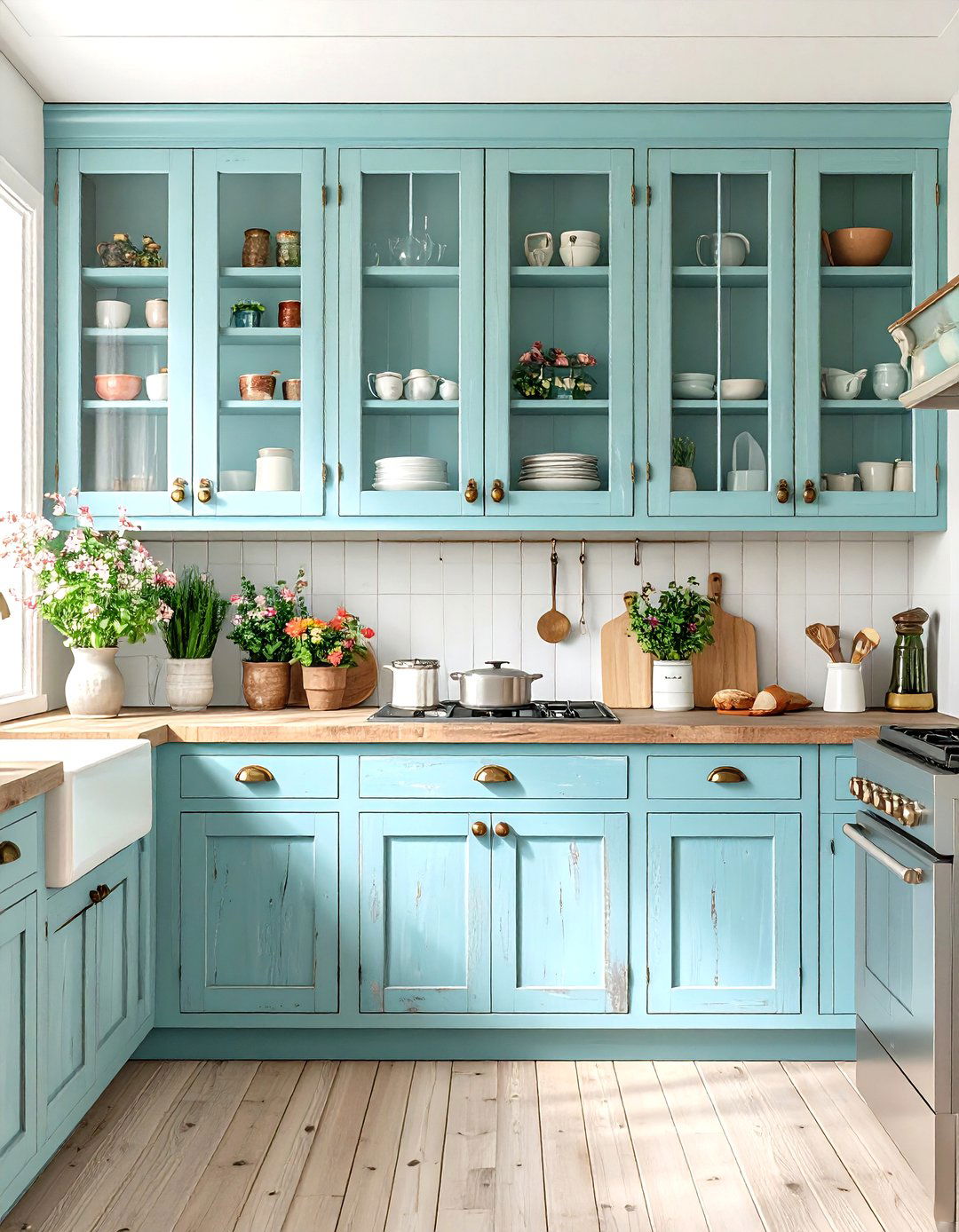
Are you seeking the easiest path to cabinet transformation? Chalk paint offers unparalleled simplicity for DIY enthusiasts, requiring minimal preparation while delivering beautiful, textured finishes. This specialty paint adheres to most surfaces without priming or sanding, making it perfect for busy homeowners. Chalk paint creates naturally matte, slightly textured surfaces that work beautifully in farmhouse, cottage, or shabby chic kitchens. The paint's forgiving nature allows for easy touch-ups and color blending. Finish with clear or tinted wax for protection and subtle sheen. While slightly more expensive than traditional paint, chalk paint's ease of use and unique finish quality make it worthwhile for many projects. Perfect for creating vintage or distressed looks.
12. Stenciled Pattern Cabinet Decoration
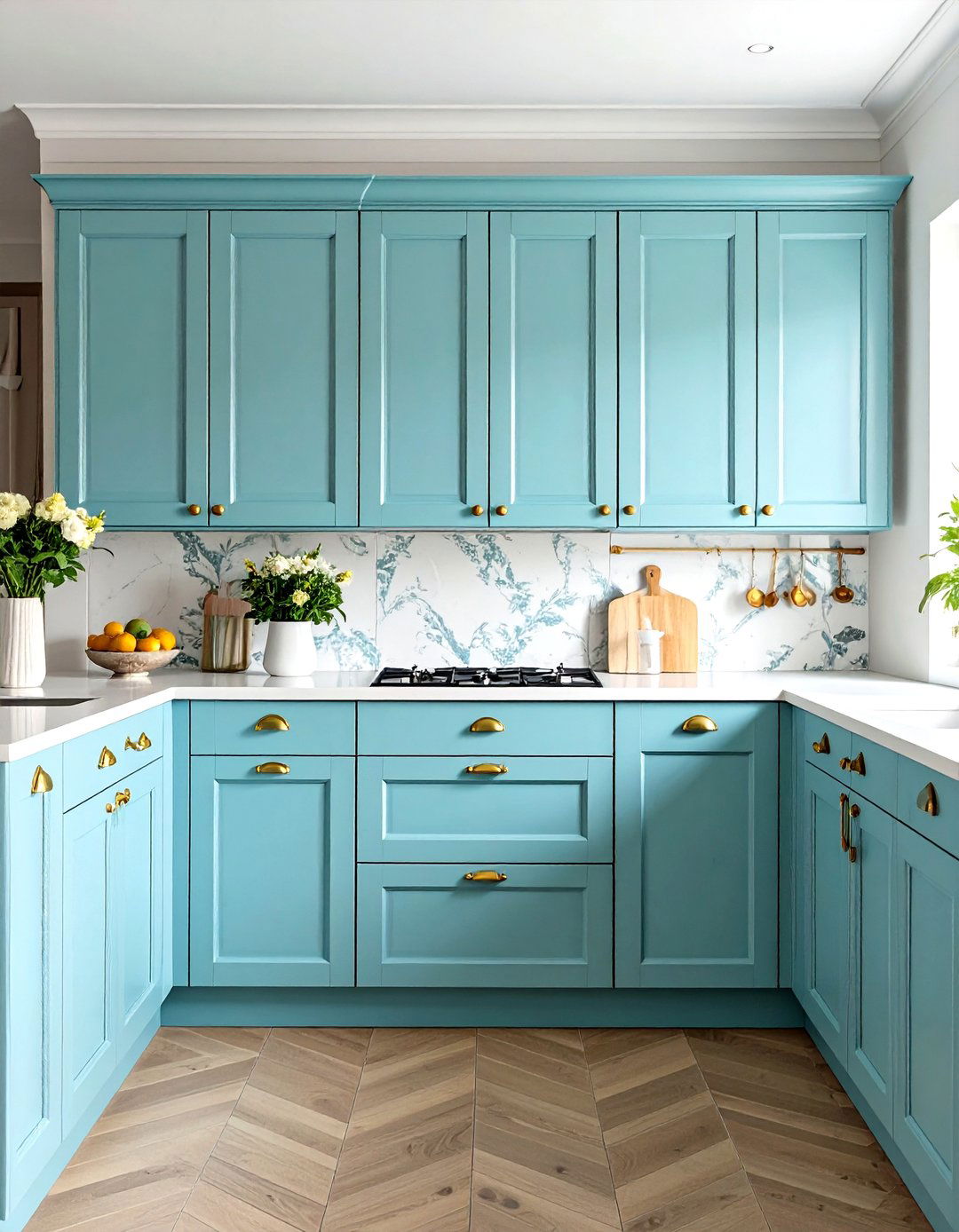
How can you add custom designer details without hiring professionals? Stenciling transforms plain cabinet doors into decorative masterpieces with endless pattern possibilities. Choose from geometric designs for modern appeal, damask patterns for traditional elegance, or botanical motifs for natural themes. The key lies in selecting appropriate stencil sizes for your cabinet doors and maintaining consistent alignment. Use high-quality stencils and specialty stencil brushes for crisp, professional results. Consider metallic paints for glamorous effects or subtle tone-on-tone approaches for sophisticated texture. Stenciling works particularly well on flat-panel doors where patterns can be fully appreciated. This technique allows complete customization while remaining budget-friendly for creative homeowners seeking unique kitchen personalities.
13. Nearly Black Dramatic Cabinet Impact
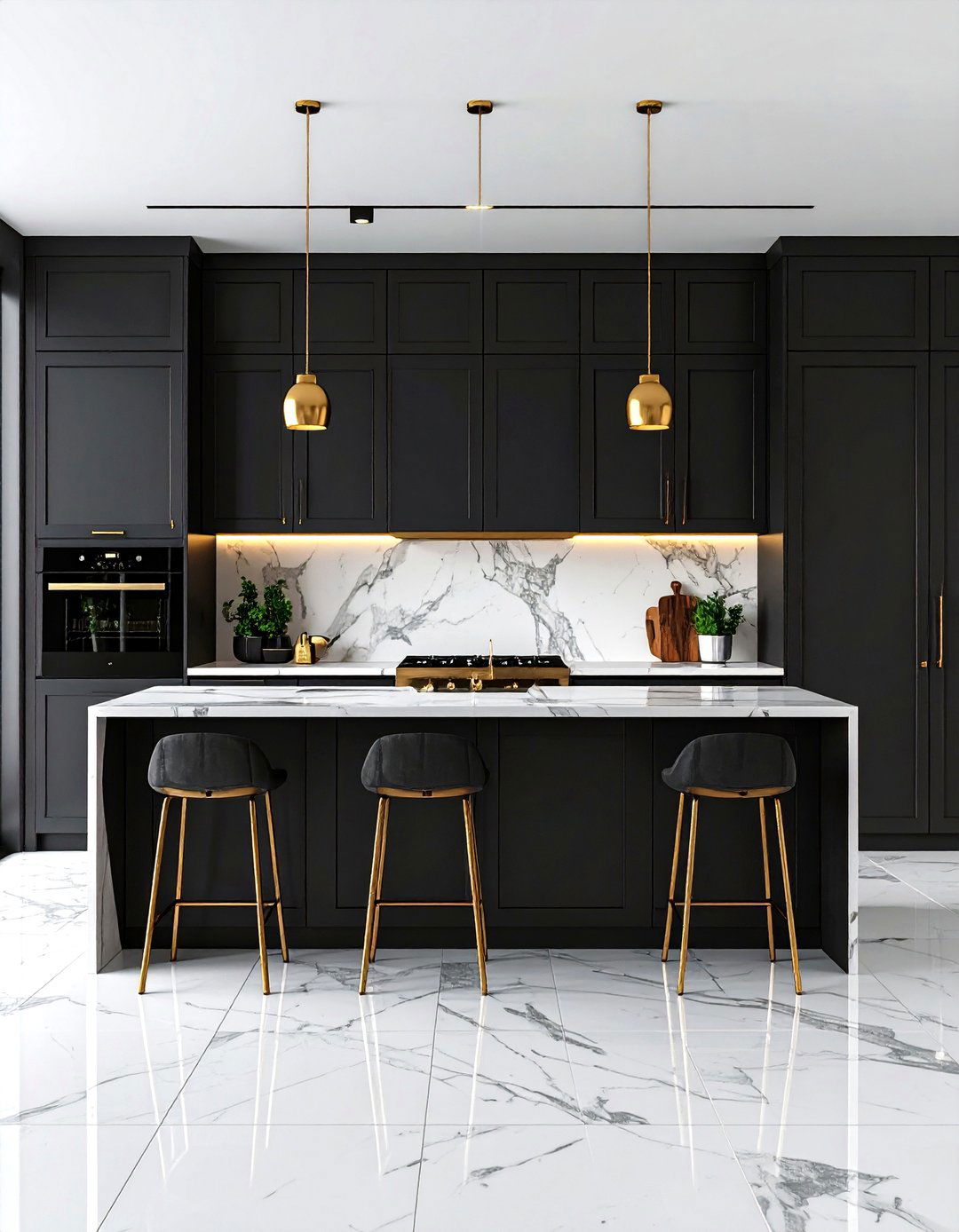
What creates the ultimate statement in sophisticated kitchen design? Nearly black cabinets offer dramatic elegance while remaining more versatile than true black. These deep, rich tones—like charcoal, graphite, or deep forest—provide striking backdrops for light countertops and metallic accents. The sophisticated darkness works beautifully in both traditional and contemporary settings, creating luxury hotel-like atmospheres. Balance dark cabinets with plenty of light through large windows, light walls, and reflective surfaces. Consider this bold choice for kitchen islands to create stunning focal points, or use throughout larger kitchens with abundant natural light. Nearly black cabinets pair beautifully with brass, gold, or warm bronze hardware for rich, layered sophistication.
14. Soft Pastel Blue Cabinet Serenity
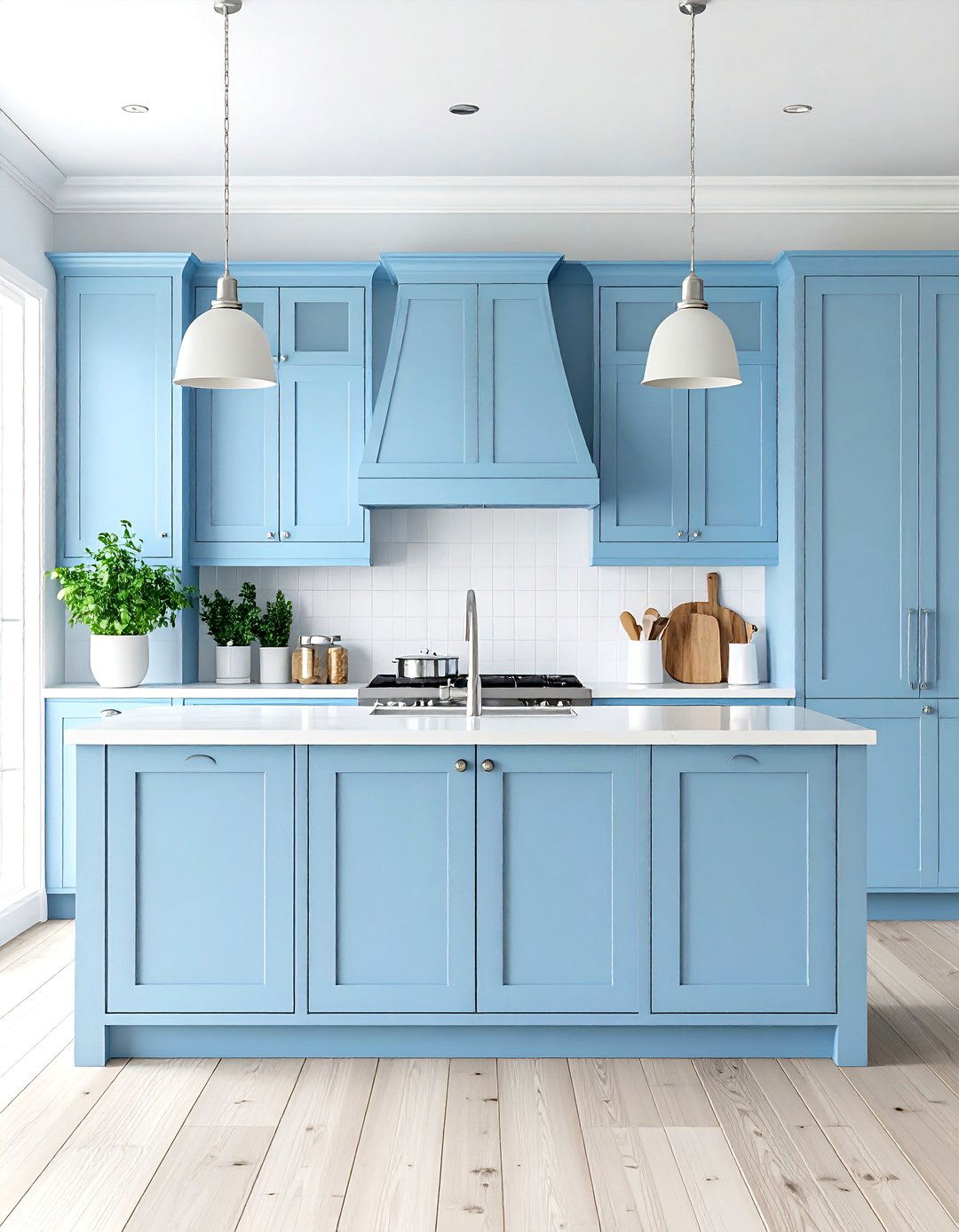
Could your kitchen become a peaceful retreat with calming pastel blue tones? Soft blues create serene, spa-like atmospheres perfect for busy households seeking tranquility. These gentle hues work beautifully in cottage, coastal, or traditional kitchen designs while remaining sophisticated enough for contemporary spaces. Popular shades include powder blue, robin's egg, or soft periwinkle—each offering different moods and compatibilities. Pastel blues pair beautifully with white trim, natural wood elements, and metallic accents in silver or pewter. The color's versatility allows for seasonal decorating flexibility while maintaining year-round appeal. Consider this soothing choice for breakfast nooks or family kitchen areas where calm, welcoming atmospheres enhance daily routines and family connections.
15. Warm Terracotta Earth Cabinet Tones
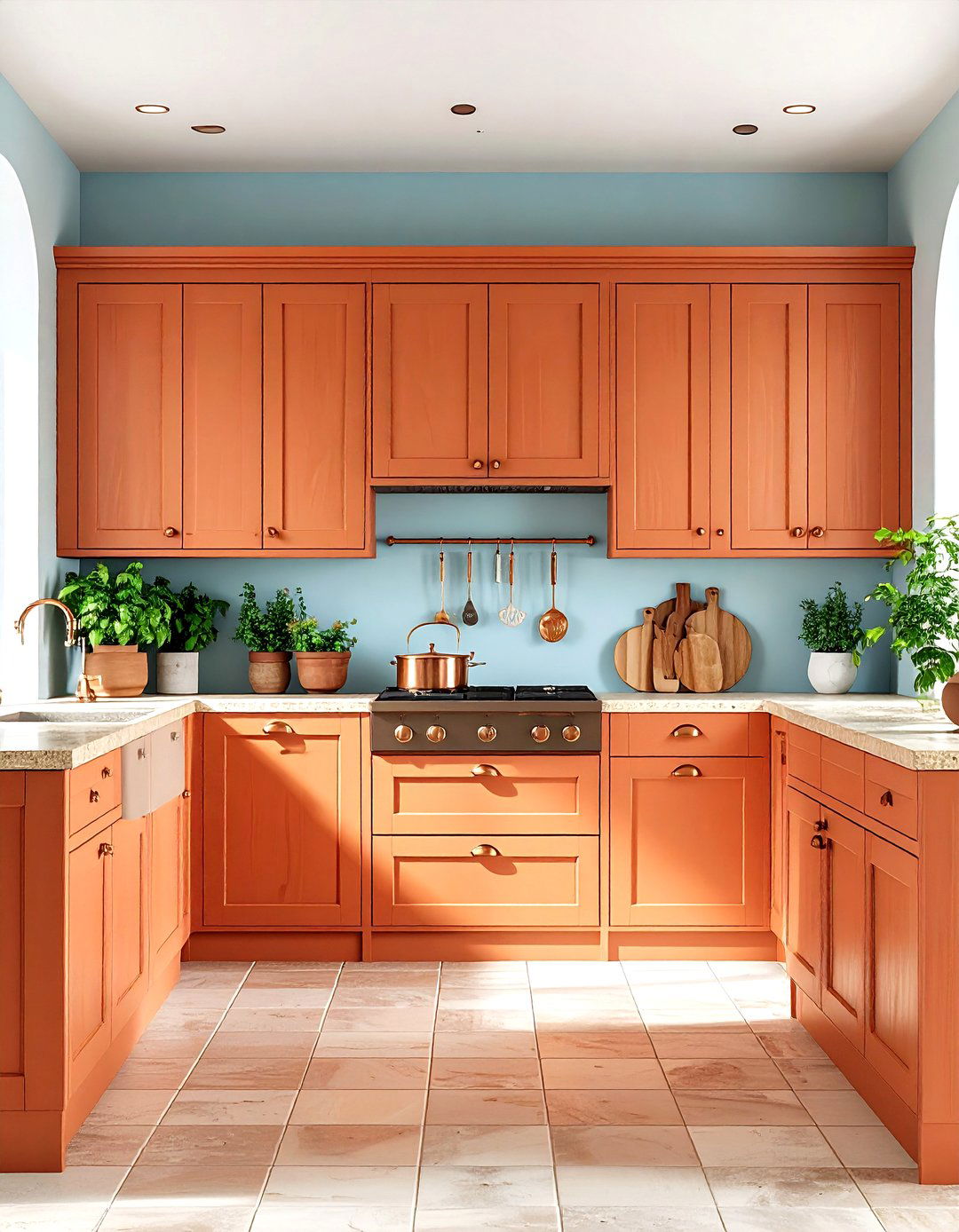
Are you drawn to the cozy warmth of earth-inspired color palettes? Terracotta and warm clay tones bring natural sophistication to kitchen cabinets while creating inviting, nurturing atmospheres. These rich, earthy hues work beautifully in Mediterranean, southwestern, or modern farmhouse designs. Terracotta pairs exceptionally well with cream trim, natural stone surfaces, and warm wood accents. The color's inherent warmth makes kitchens feel welcoming and lived-in without appearing dated. Consider these tones for accent areas or full cabinet coverage in kitchens with abundant natural light. The sophisticated earthiness works particularly well with copper or bronze hardware and natural fiber accessories. These colors create kitchens that feel grounded, warm, and authentically connected to natural elements.
16. Crackling Vintage Cabinet Technique
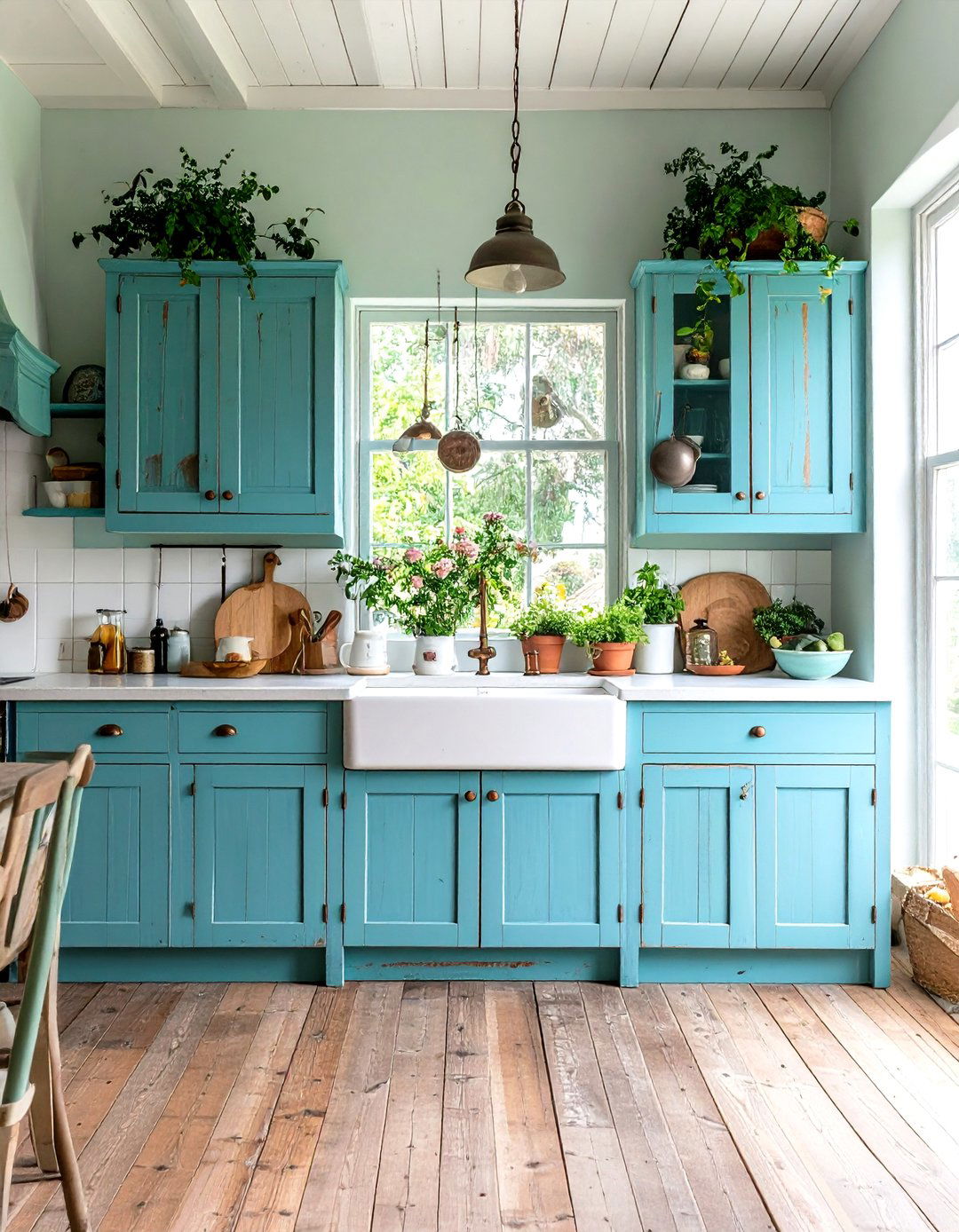
Do you love the authentic character of genuinely aged furniture? Crackling techniques create realistic aging effects that make new cabinets appear beautifully weathered by time. This specialty finish involves applying crackle medium between base and top coats, creating natural-looking cracks as the paint dries. The size and pattern of cracks can be controlled through application techniques and drying conditions. Popular color combinations include cream base with darker topcoats, or white base with soft gray finishing layers. The authentic aging effect works particularly well in cottage, farmhouse, or vintage-inspired kitchens. While requiring patience and practice, crackling creates genuinely unique finishes impossible to achieve through other methods. Perfect for homeowners seeking one-of-a-kind character.
17. Kitchen Island Accent Color Focus
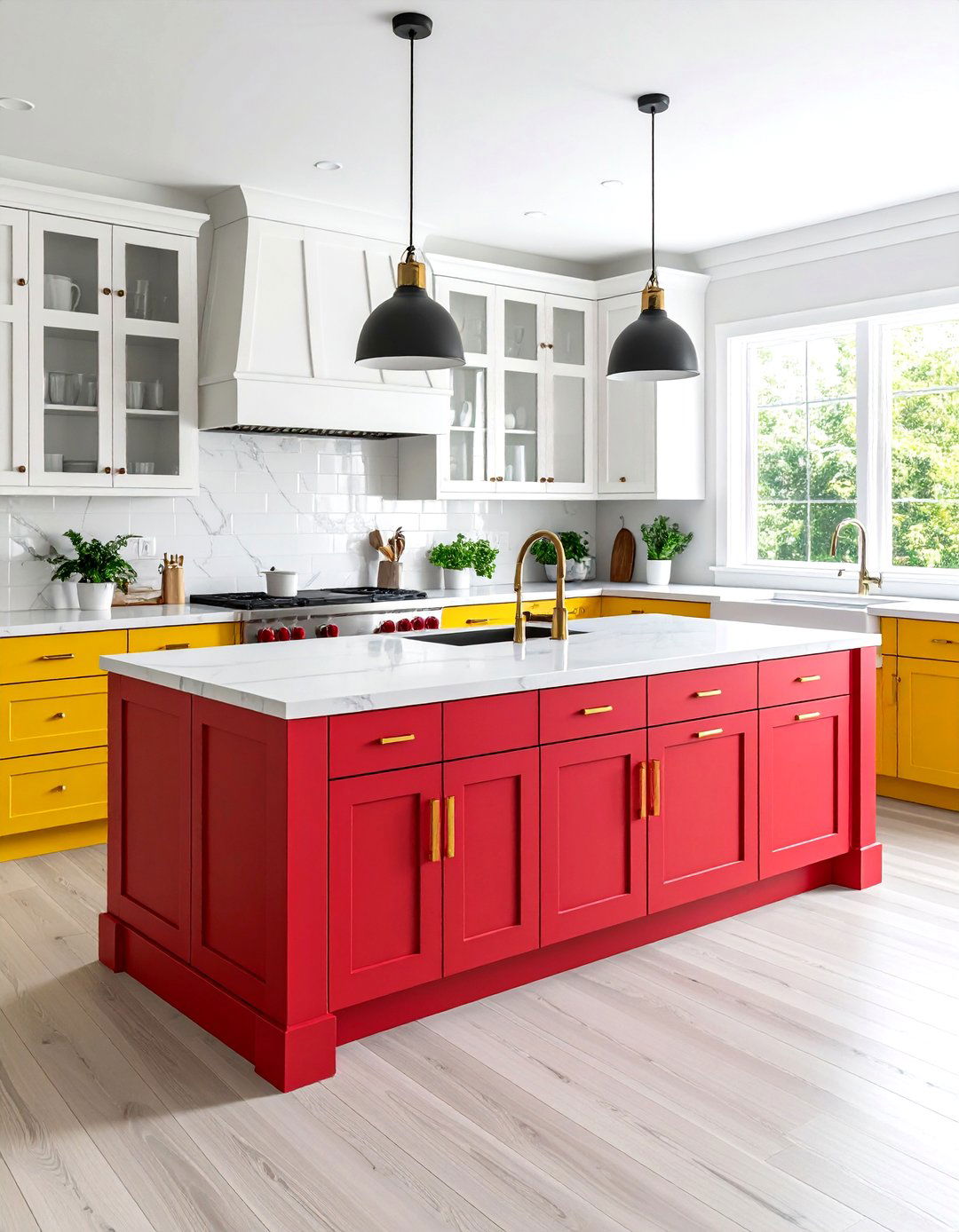
Why not create a stunning focal point with bold island cabinet colors? Painting kitchen islands in contrasting or accent colors adds visual interest while maintaining versatility in the broader kitchen design. This approach allows experimentation with bolder colors—deep blues, rich greens, or dramatic blacks—without overwhelming the entire space. Island accent colors work beautifully when they coordinate with other kitchen elements like backsplashes, artwork, or window treatments. Popular combinations include white perimeter cabinets with navy islands, gray cabinets with natural wood islands, or cream cabinets with sage green focal points. This strategy creates natural gathering areas while adding personality and sophistication. Perfect for open-concept homes where islands serve as transitional elements between kitchen and living spaces.
18. Metallic Accent Cabinet Finishes
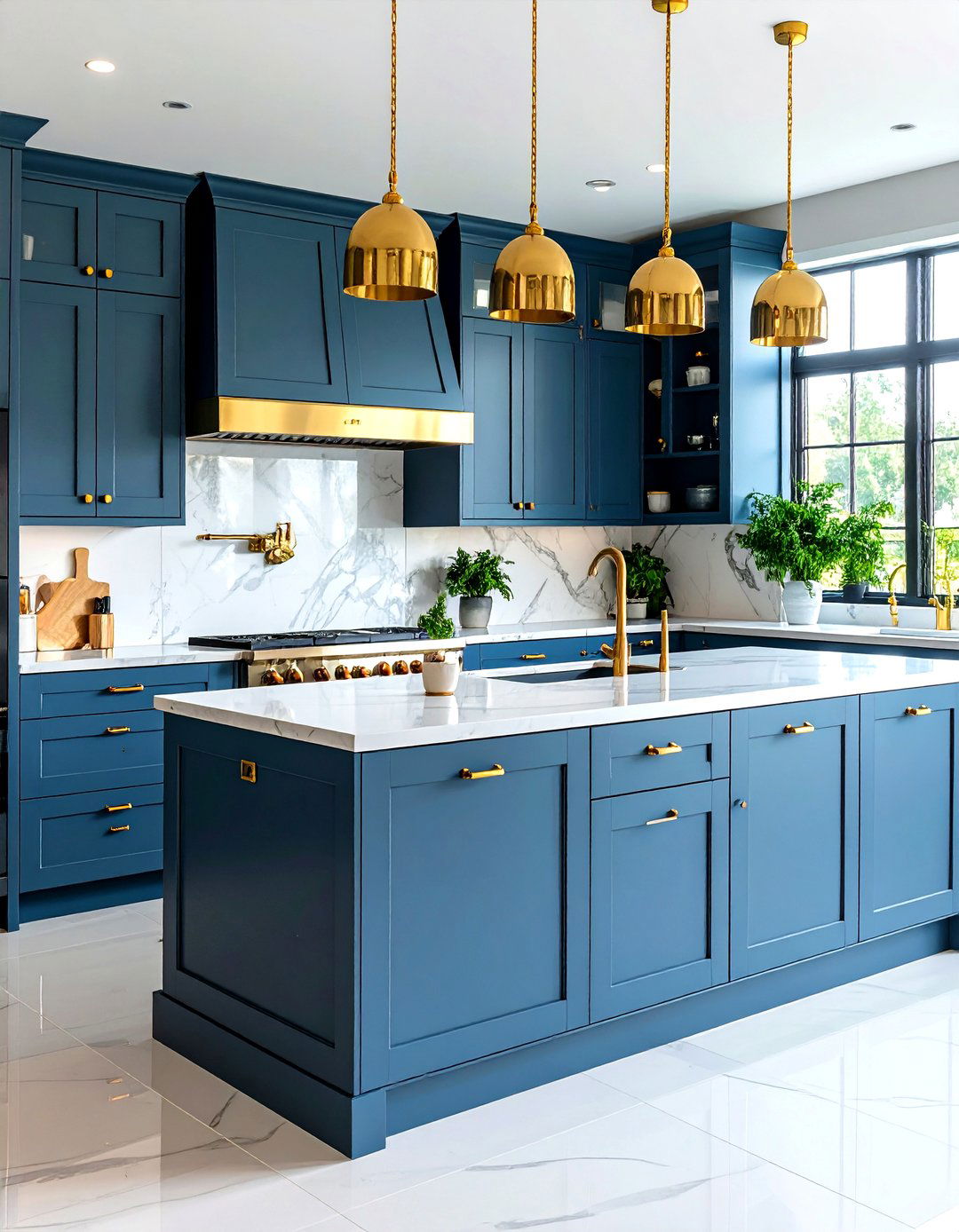
Could subtle metallic touches elevate your kitchen cabinets to luxury status? Metallic accent finishes add sophisticated glamour through strategic highlighting rather than full coverage. Consider brushing metallic glazes over raised panel details, adding metallic stenciling, or incorporating metallic hardware coordination. Popular choices include warm golds, soft silvers, or rich copper tones that complement your overall color scheme. The key lies in restraint—metallic accents should enhance rather than dominate the design. These finishes work particularly well in transitional or contemporary kitchens where subtle luxury matters. Metallic touches can tie together various kitchen elements while adding depth and visual interest. Perfect for homeowners seeking sophisticated enhancement without complete color transformation.
19. Chalkboard Paint Functional Cabinet Design
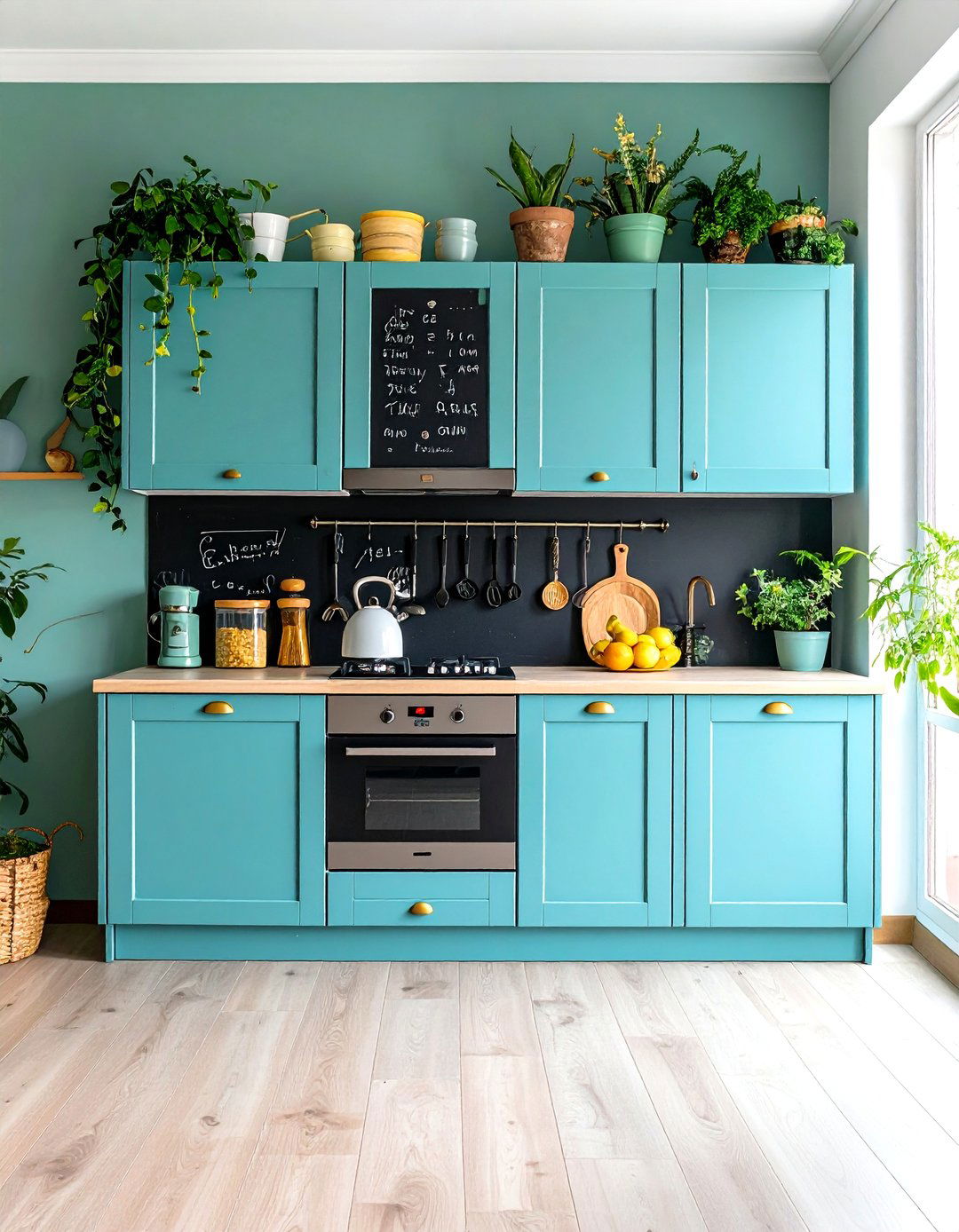
What if your kitchen cabinets could serve double duty as functional message centers? Chalkboard paint transforms select cabinet surfaces into practical writing areas for grocery lists, family messages, or recipe notes. This innovative approach works particularly well on pantry doors, cabinet ends, or inside cabinet doors for hidden functionality. Quality chalkboard paint creates smooth, durable writing surfaces that clean easily with damp cloths. Consider framing chalkboard areas with decorative molding for polished, intentional appearances. The functional beauty appeals to busy families while adding unique personality to kitchen designs. Chalkboard surfaces can also display seasonal decorations, children's artwork, or inspirational quotes. This practical painting solution combines creativity with everyday functionality.
20. Color Washing Cabinet Technique
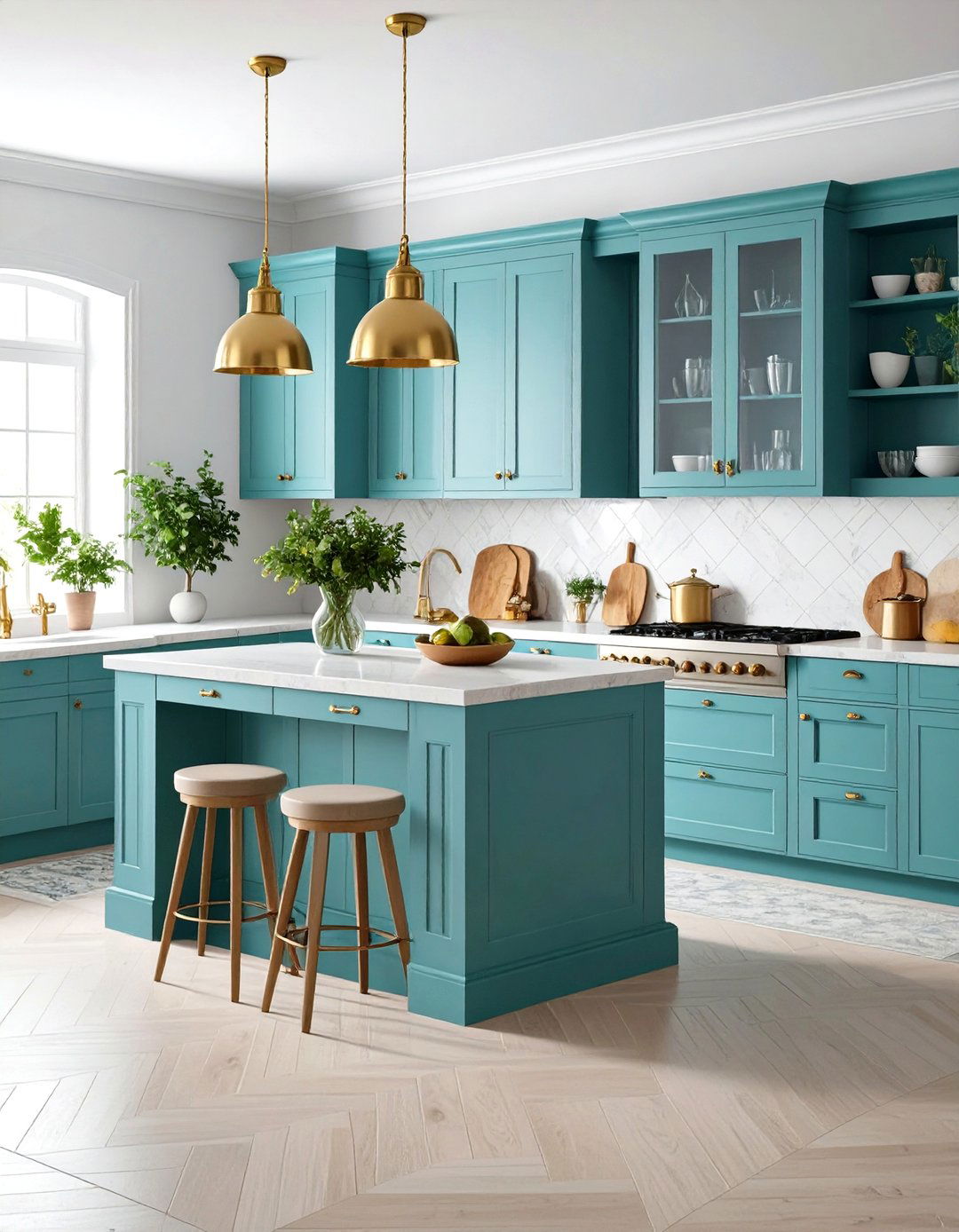
Are you seeking subtle texture and depth beyond solid color coverage? Color washing techniques create beautiful, sophisticated effects through layered transparent glazes. This artistic approach involves applying thin, translucent color washes over base coats using various tools—rags, sponges, or specialty brushes—to create organic, cloud-like patterns. The technique works beautifully in traditional or Mediterranean-style kitchens where texture and depth matter more than solid color uniformity. Popular color combinations include warm whites with golden washes, soft grays with blue undertones, or cream bases with subtle brown glazing. Success requires practice and patience, but results offer unique, hand-crafted appearances impossible to achieve through standard painting. Perfect for artistic homeowners seeking one-of-a-kind cabinet finishes.
21. Sponge Painting Cabinet Texture
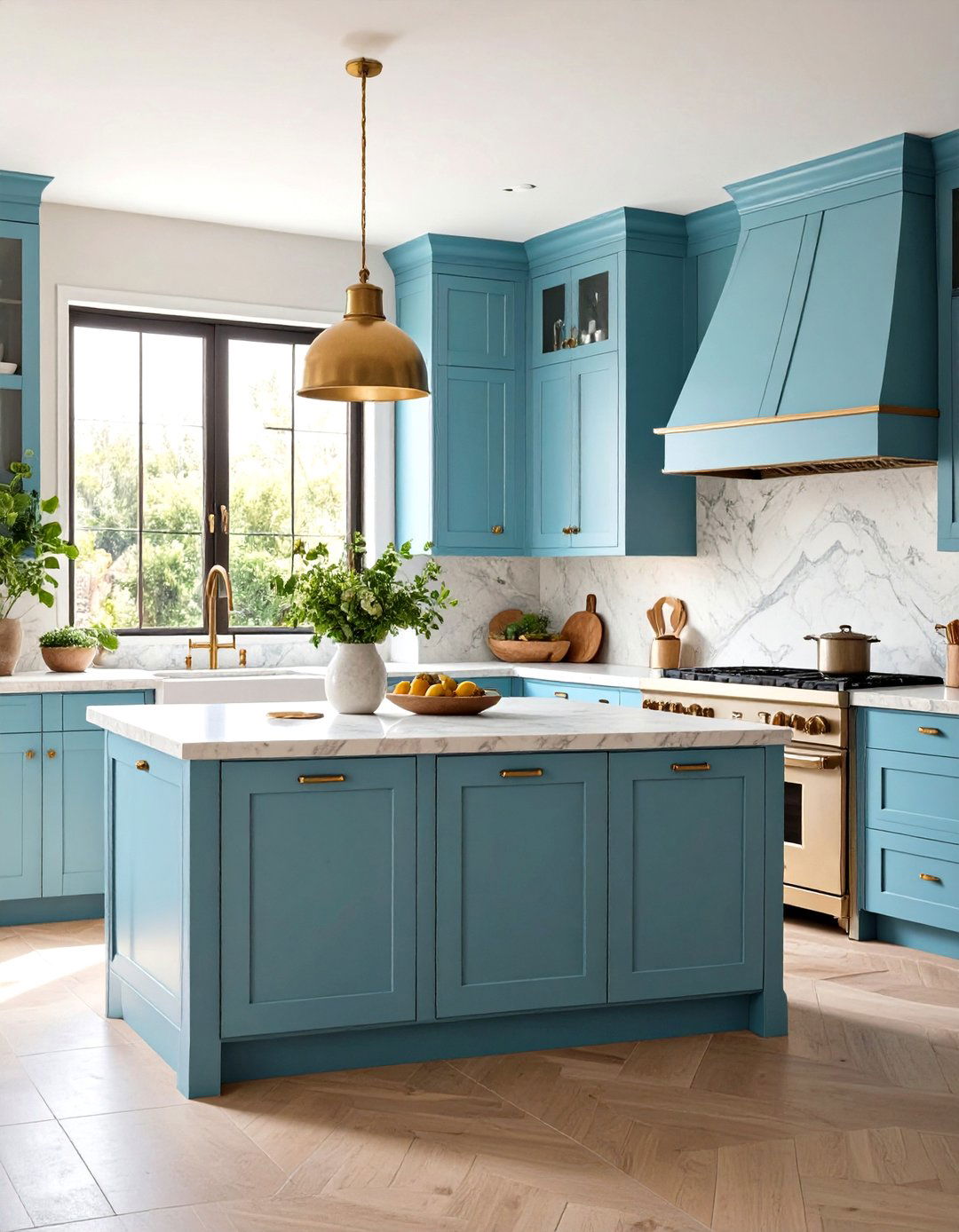
Could natural sponge techniques add organic texture to your cabinet transformation? Sponge painting creates beautiful, mottled effects that add visual interest while maintaining color cohesion. This accessible technique involves dabbing natural sea sponges loaded with paint or glaze onto base-painted surfaces, creating irregular, organic patterns. The method works particularly well for creating aged, weathered appearances or adding subtle texture to solid colors. Layer multiple colors for complex, sophisticated effects, or use single accent colors for subtle enhancement. Sponge painting pairs beautifully with Mediterranean, tuscan, or rustic kitchen designs where organic, handcrafted appearances are valued. The forgiving nature of this technique makes it perfect for DIY enthusiasts seeking professional-looking results without extensive artistic training.
22. Wood Stain Over Paint Cabinet Layering
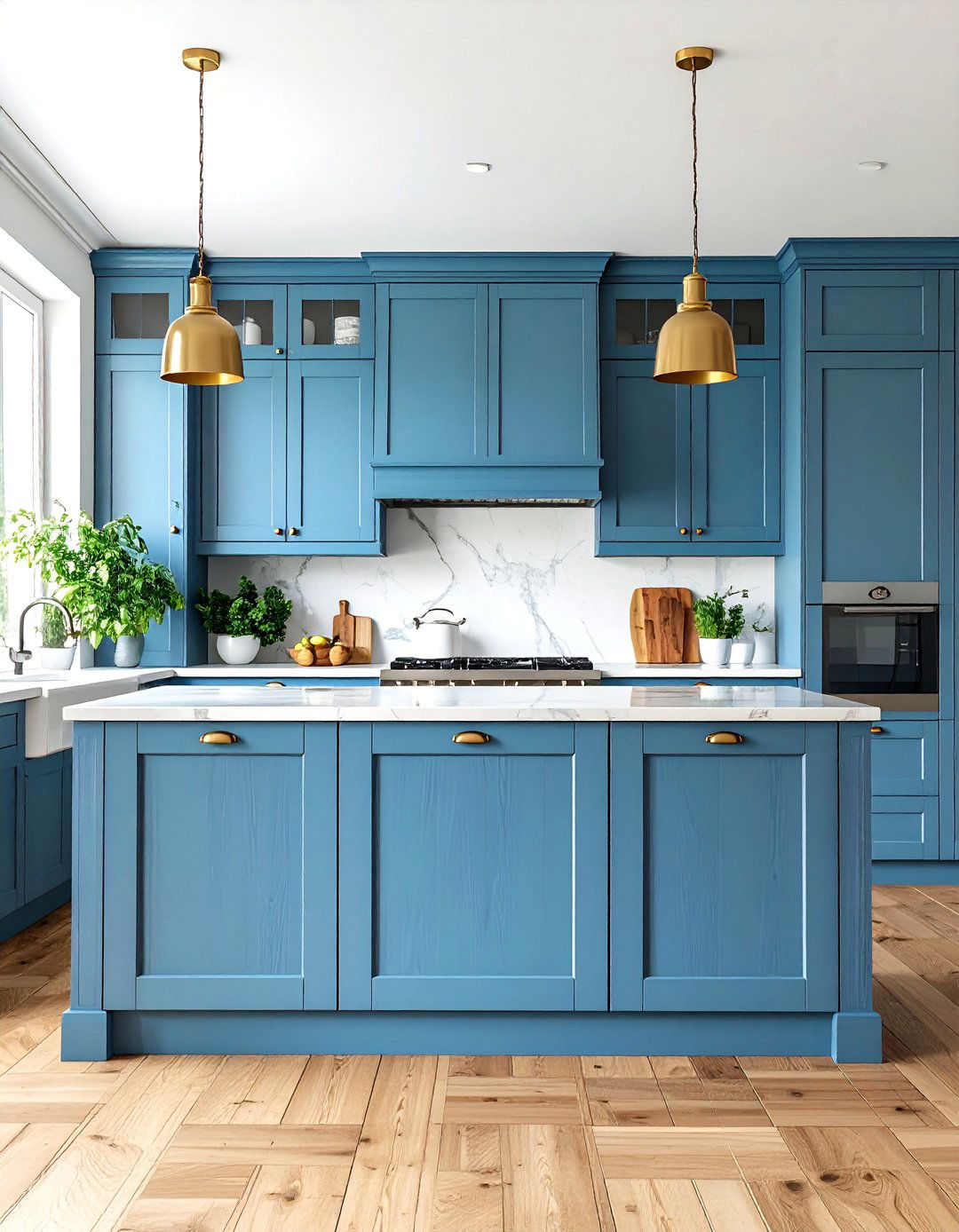
What happens when you combine the best of paint and natural wood finishes? Layering wood stain over painted surfaces creates unique, complex finishes with remarkable depth and character. This advanced technique involves painting cabinets, then selectively applying wood stain to create highlighting, aging, or color variation effects. The stain penetrates differently over painted surfaces, creating interesting color variations and artistic effects. This approach works particularly well for creating custom, furniture-quality appearances that combine paint's coverage with stain's natural beauty. Consider this technique for achieving specific vintage or antique effects that require both color coverage and wood-like depth. Success requires experimentation and patience, but results offer truly unique, custom appearances perfect for discerning homeowners.
23. Semi-Gloss Durability Cabinet Finish
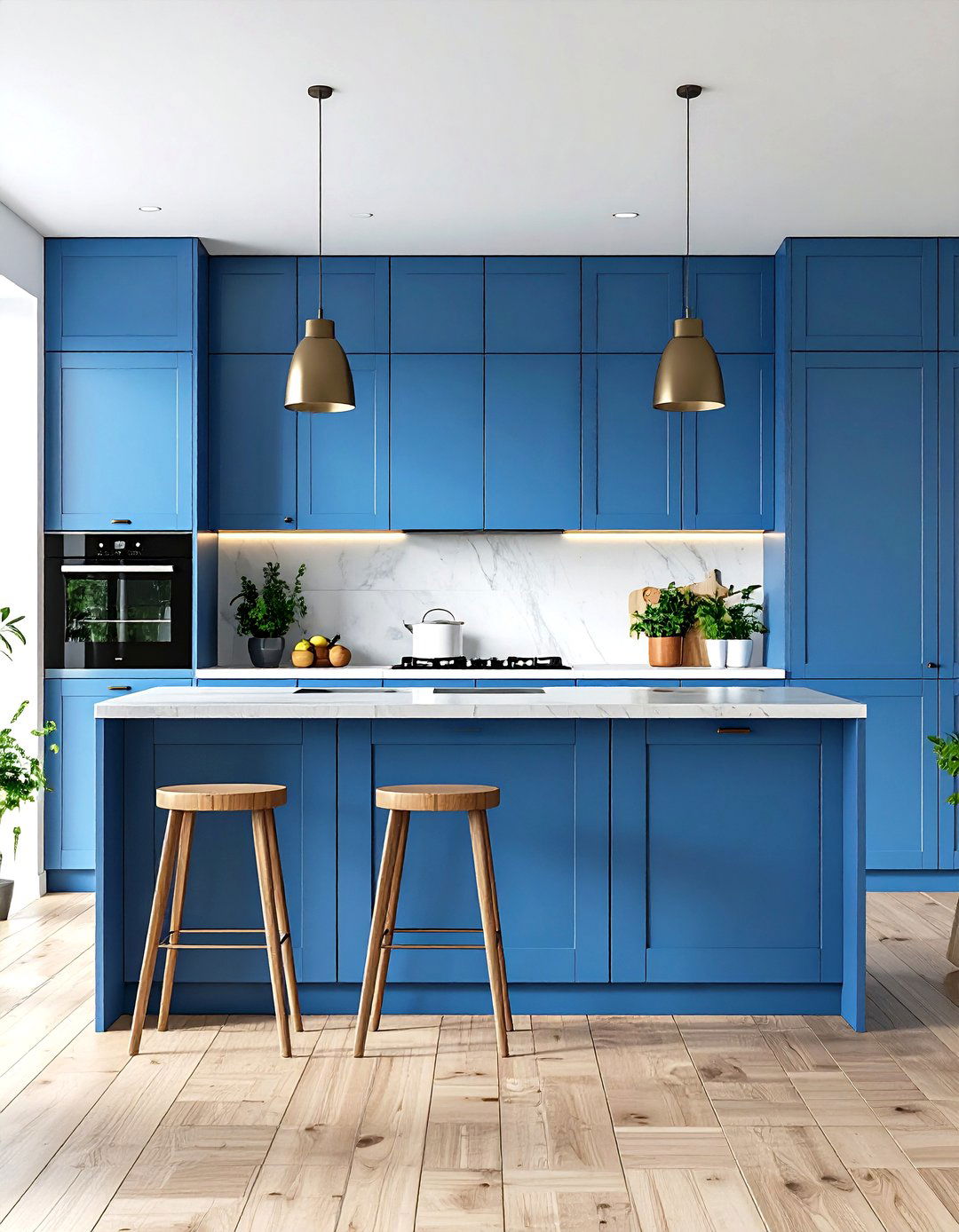
Why do professional painters consistently recommend semi-gloss finishes for kitchen cabinets? This practical choice offers the perfect balance between beauty and durability, providing subtle sheen while maintaining easy cleanability. Semi-gloss finishes resist moisture, grease, and daily wear better than matte alternatives while avoiding the high-maintenance aspects of full gloss. The slight sheen reflects light gently, adding brightness without creating harsh reflections or highlighting every imperfection. This finish works beautifully across all color palettes and design styles, from traditional to contemporary. Semi-gloss paint typically offers superior coverage and longevity, making it cost-effective for busy kitchen environments. Perfect for families seeking beautiful, practical cabinet finishes that withstand daily use while maintaining fresh appearances.
24. Milk Paint Rustic Cabinet Style
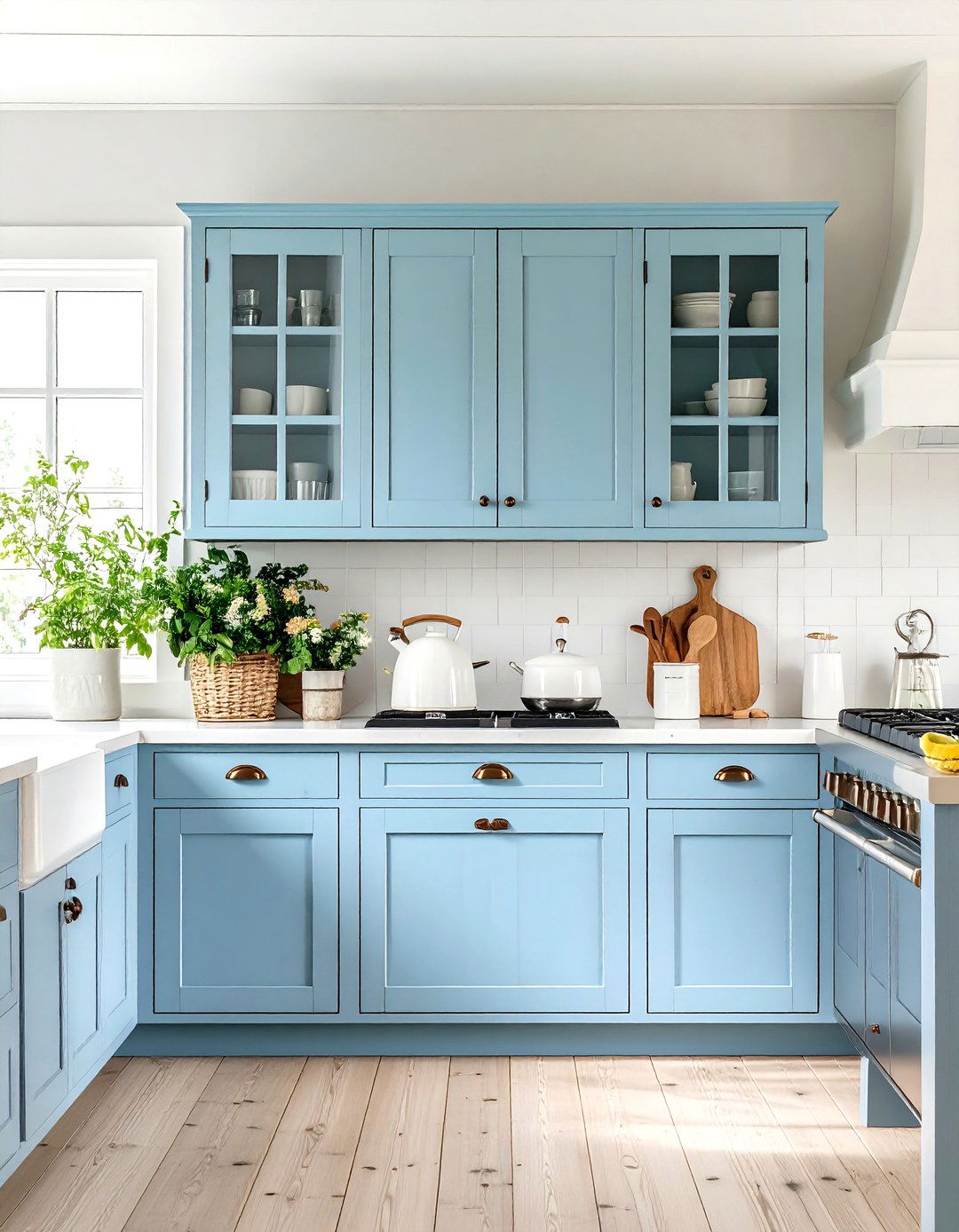
Are you seeking authentically vintage finishes with modern performance? Milk paint offers unique, matte textures with naturally distressed appearances perfect for farmhouse or cottage-style kitchens. This traditional paint type, made from milk proteins, creates naturally aged looks with subtle color variations and organic textures. Milk paint adheres beautifully to most surfaces without extensive preparation while offering easy distressing and natural wear patterns. The paint's eco-friendly composition appeals to environmentally conscious homeowners, while its unique finish characteristics create one-of-a-kind appearances. Colors tend to be softer and more muted than conventional paints, creating authentic vintage atmospheres. Success with milk paint requires understanding its unique properties, but results offer genuinely distinctive finishes perfect for authentic rustic or vintage kitchen designs.
Conclusion:
Cabinet painting offers unlimited creative potential for transforming kitchens without expensive renovations. From timeless whites to bold accent colors, sophisticated finishes to artistic techniques, each approach creates unique atmospheres reflecting personal style preferences. Success depends on proper preparation, quality materials, and understanding each technique's specific requirements. Whether choosing simple solid colors or complex layered finishes, painted cabinets provide excellent returns on investment while allowing complete customization. The current trend toward personalized, comfortable kitchens makes cabinet painting increasingly popular among homeowners seeking distinctive spaces. With patience, proper tools, and creative vision, anyone can achieve professional-quality results that enhance daily living while increasing home value and personal satisfaction.


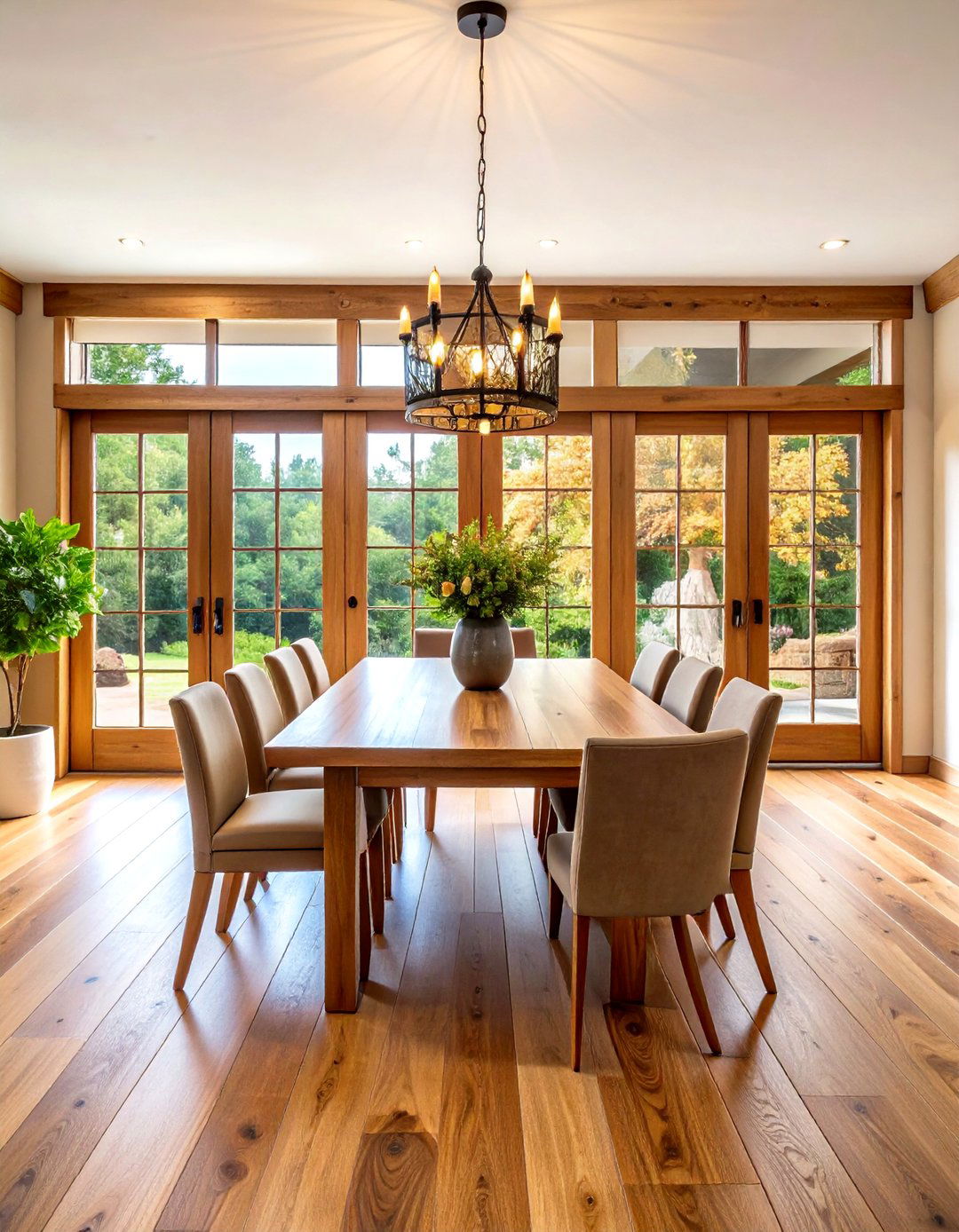

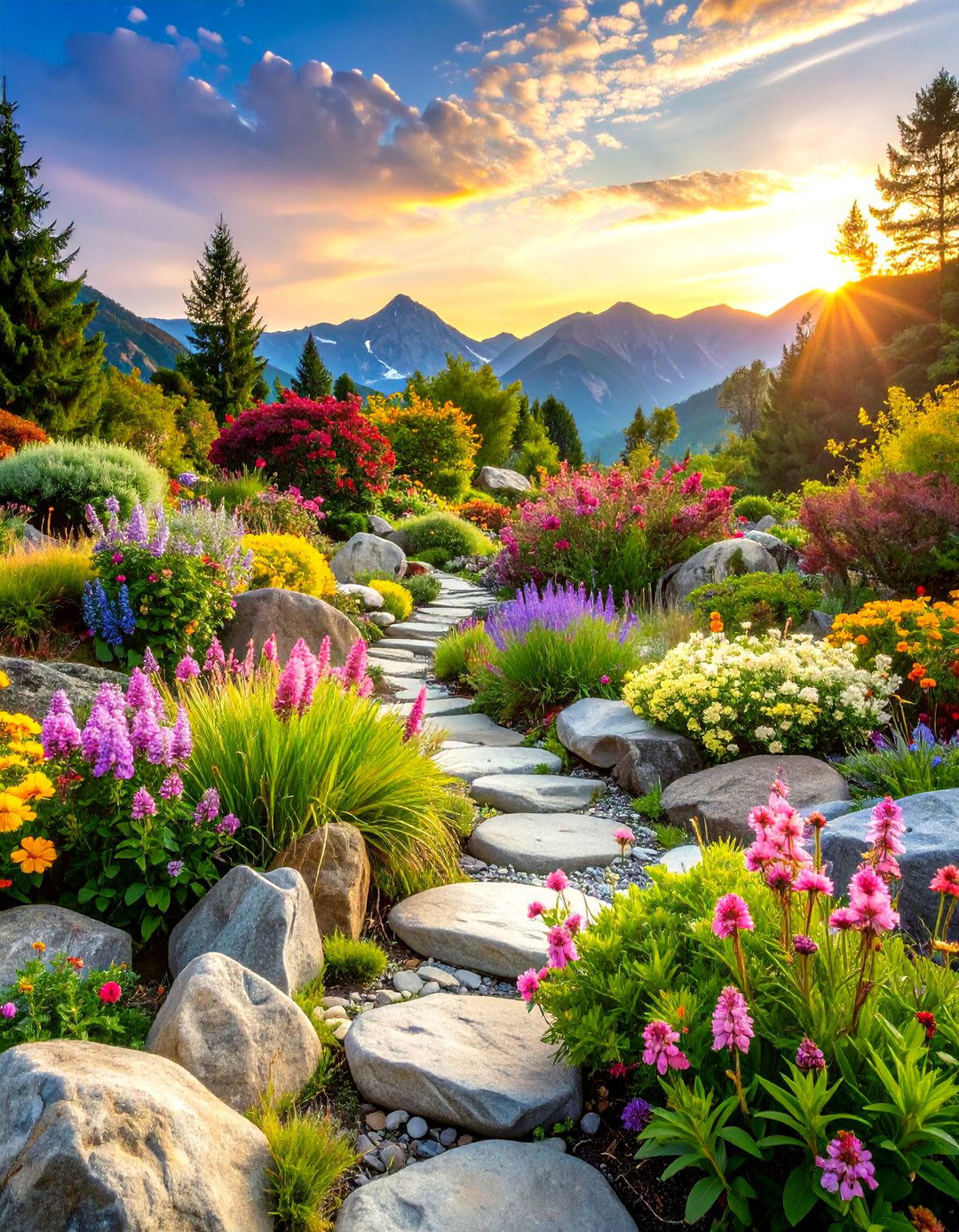



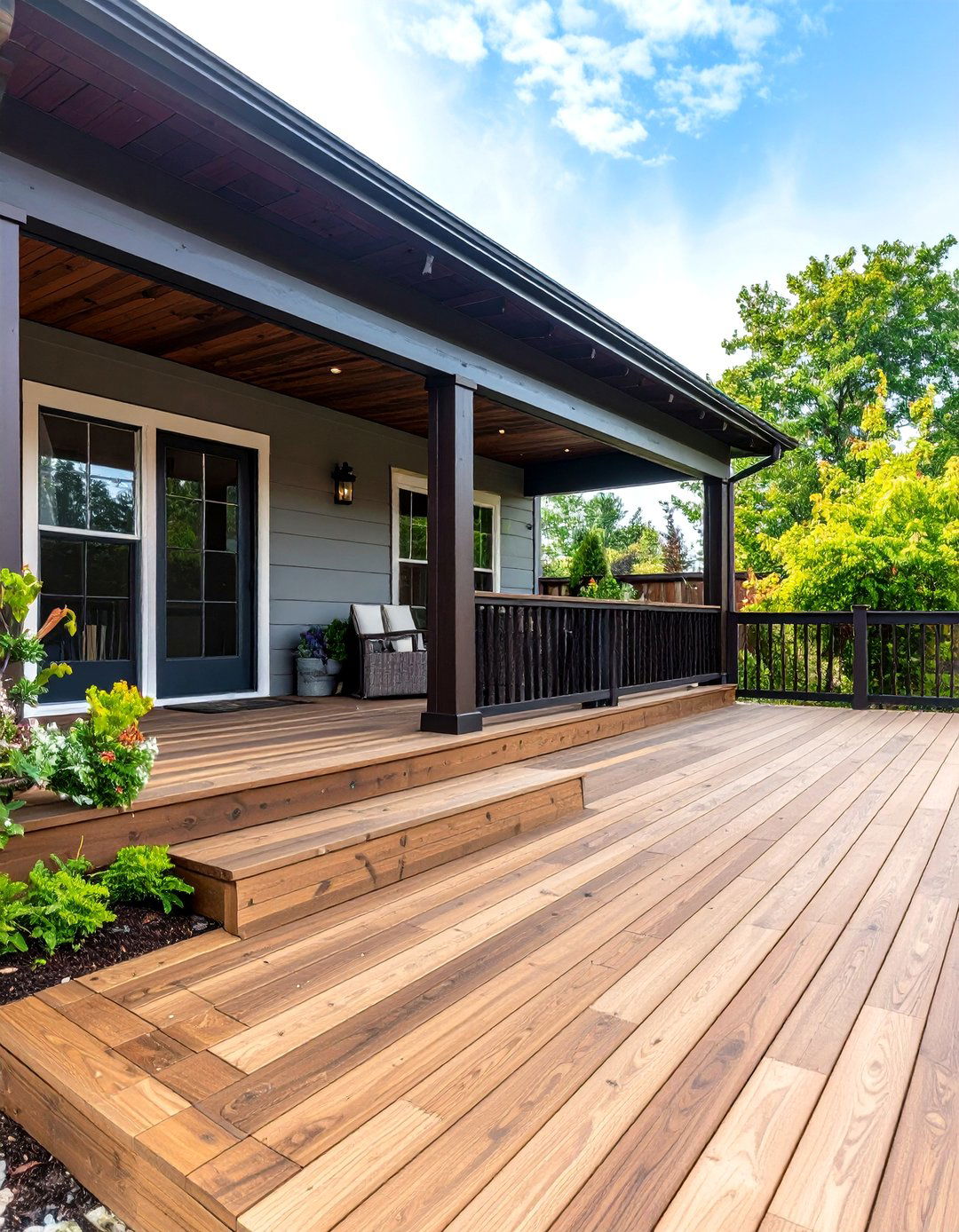
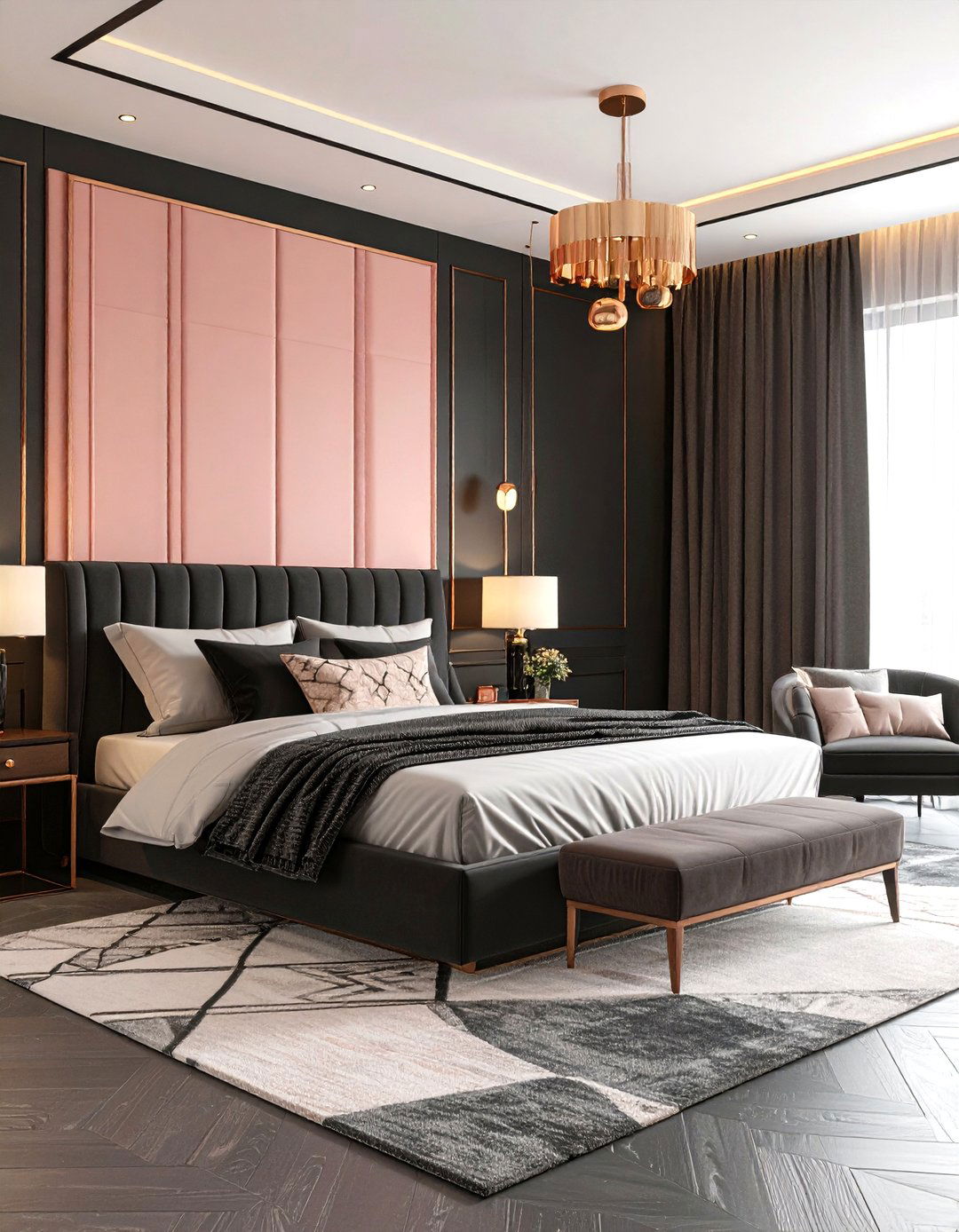
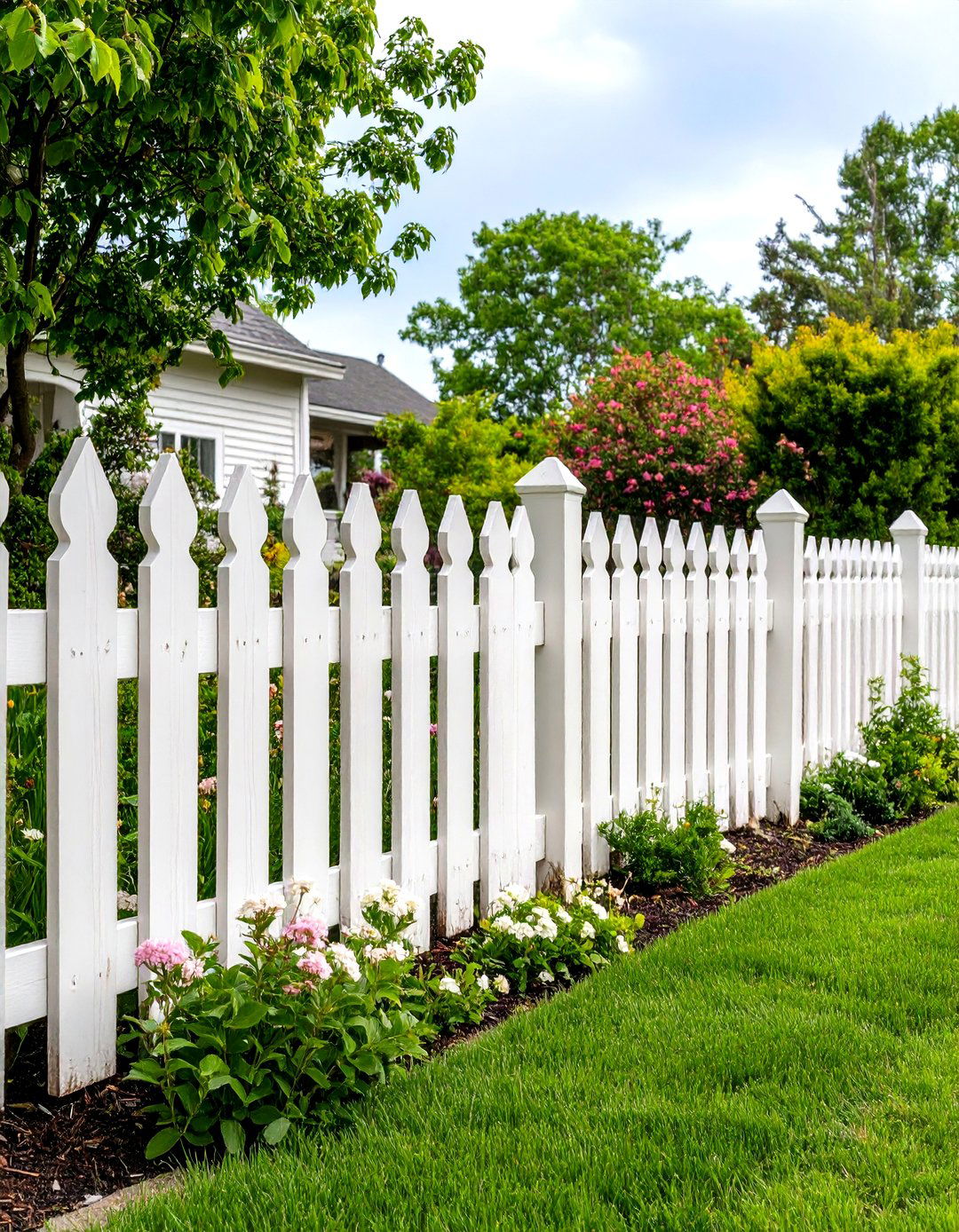
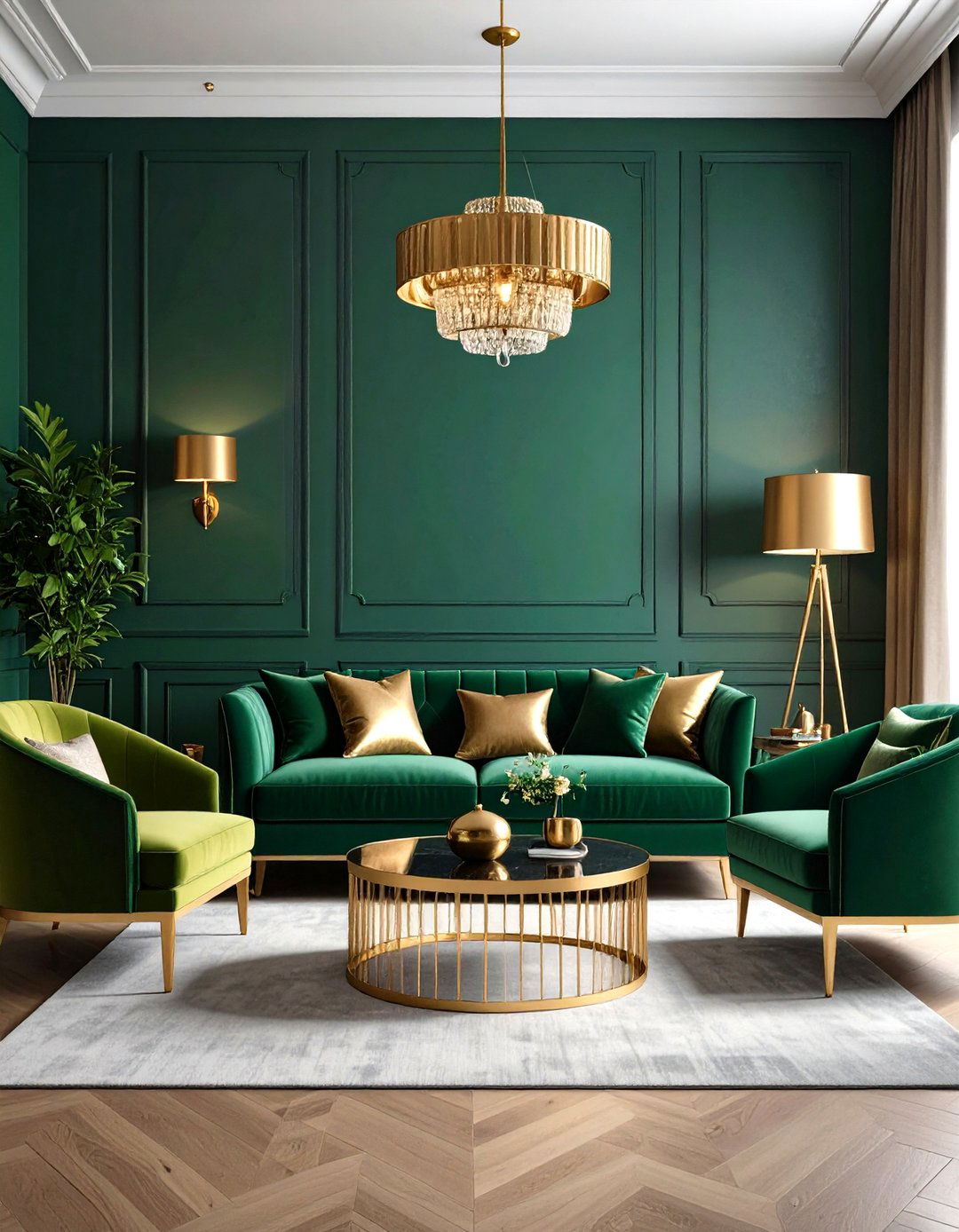

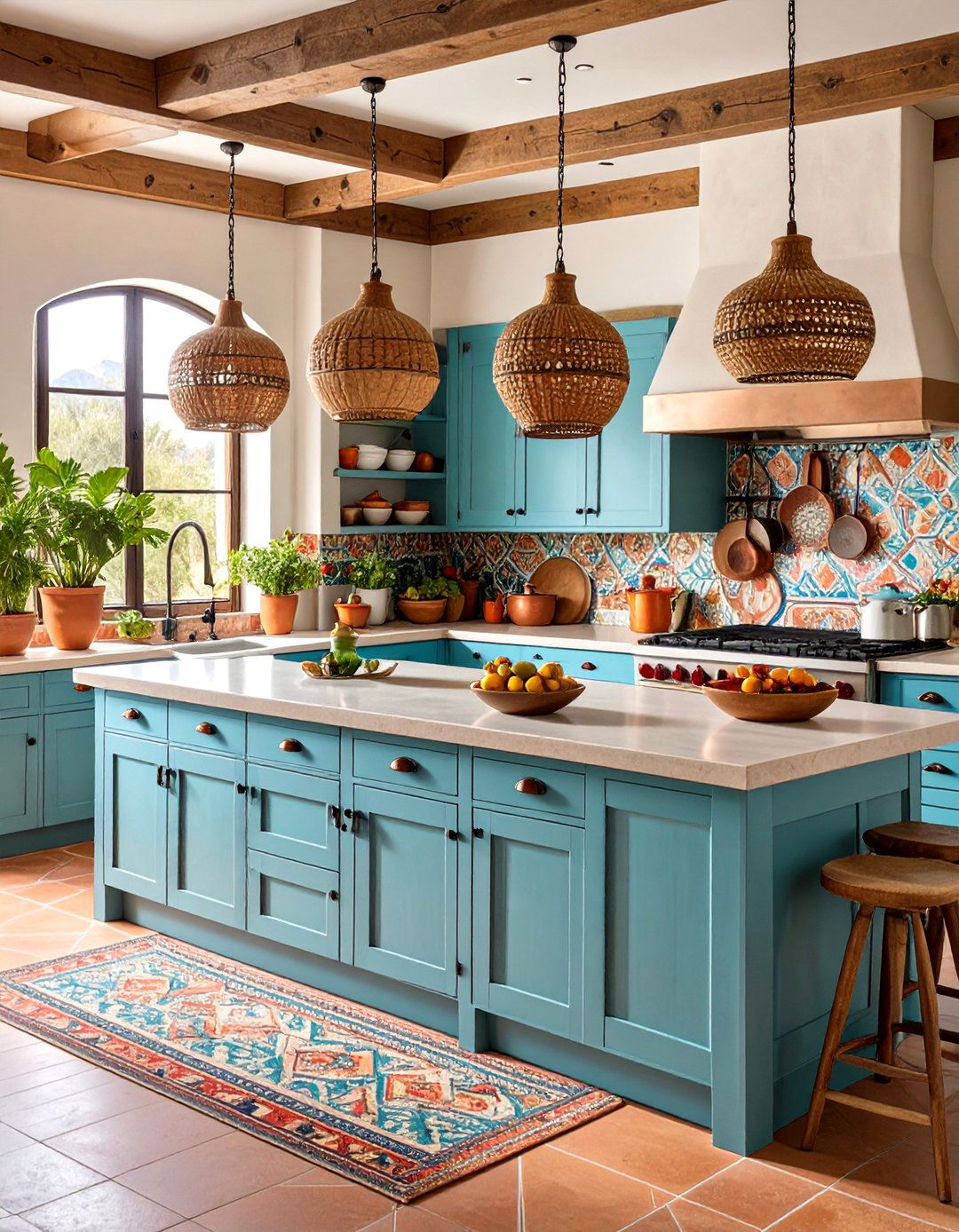
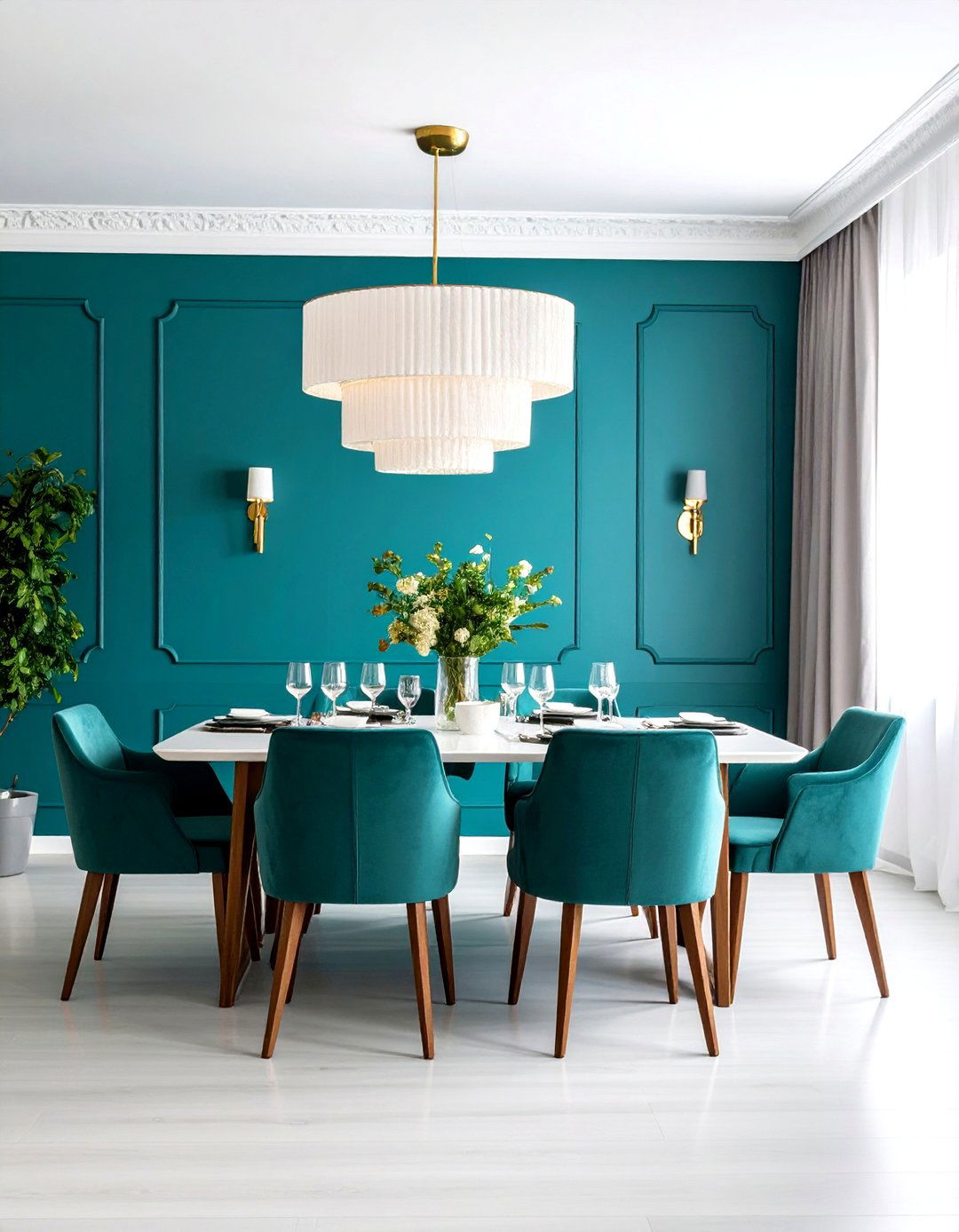
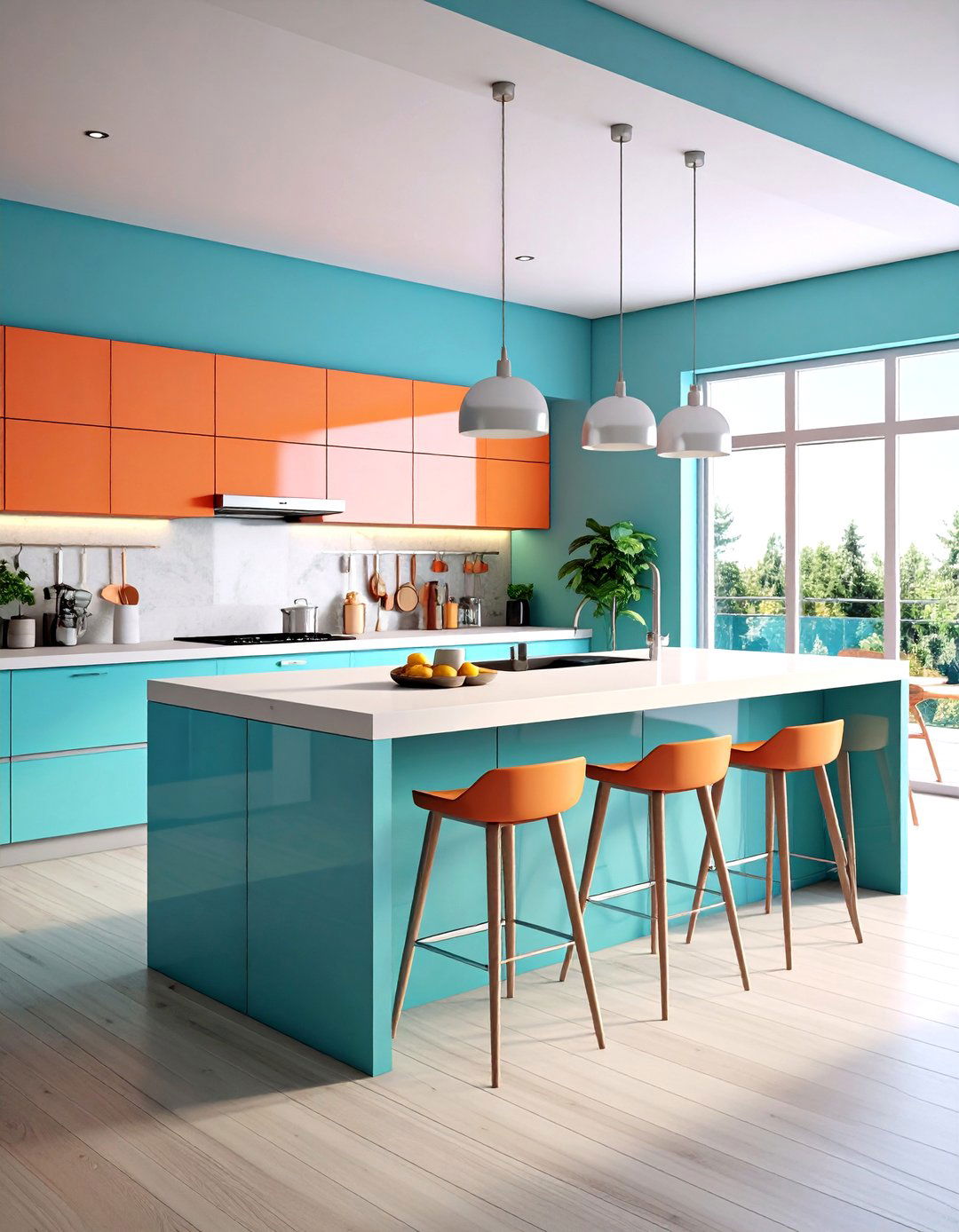
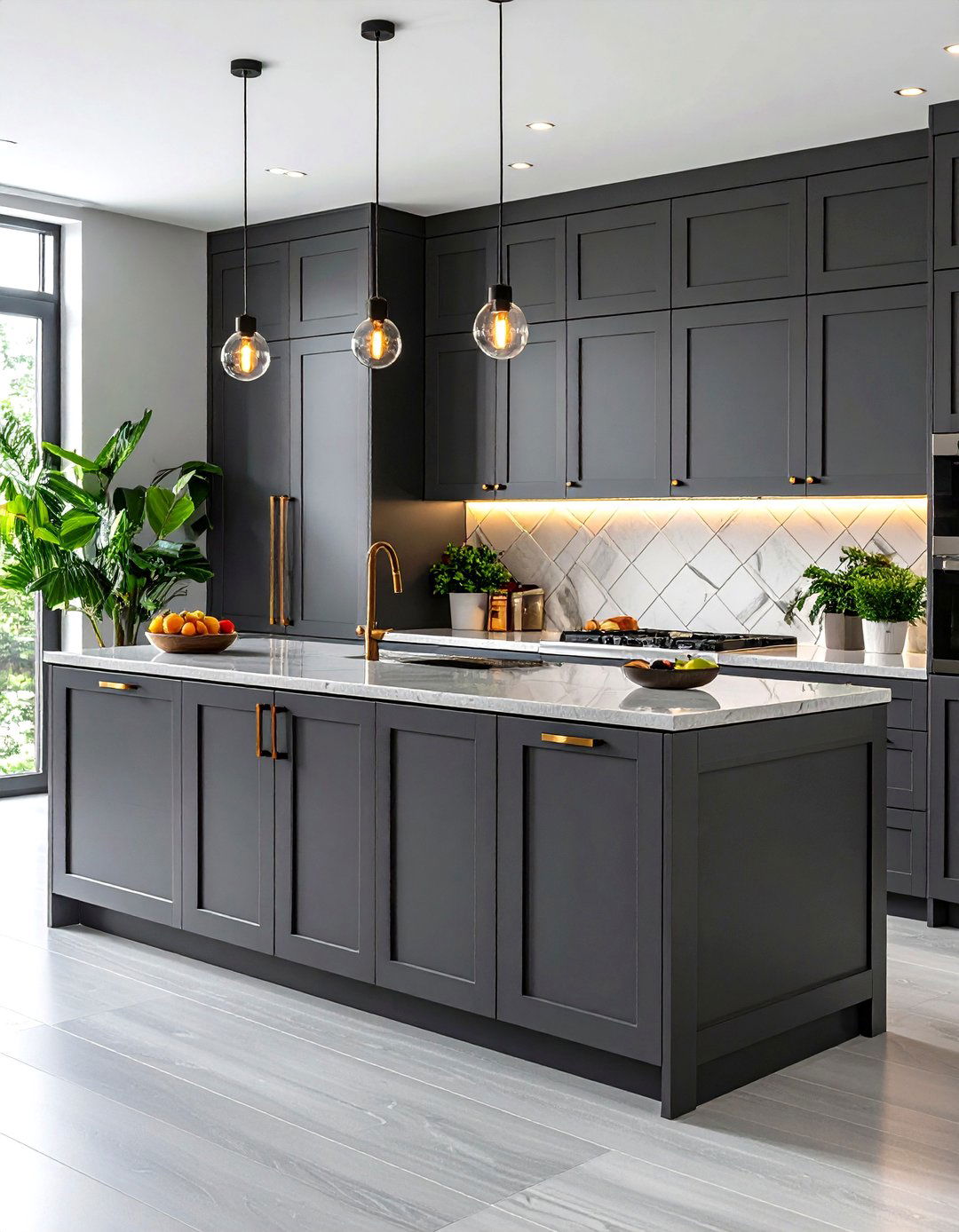
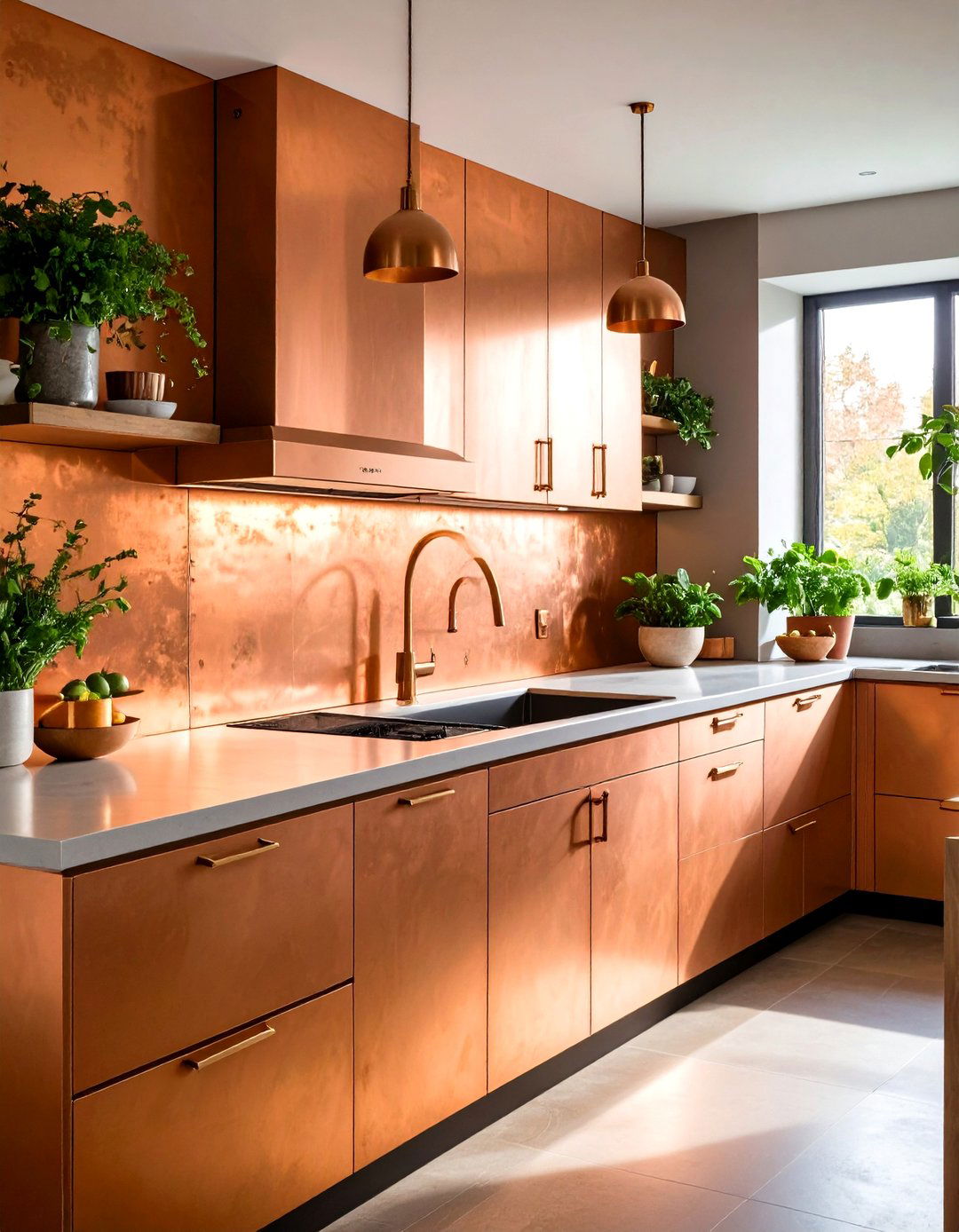

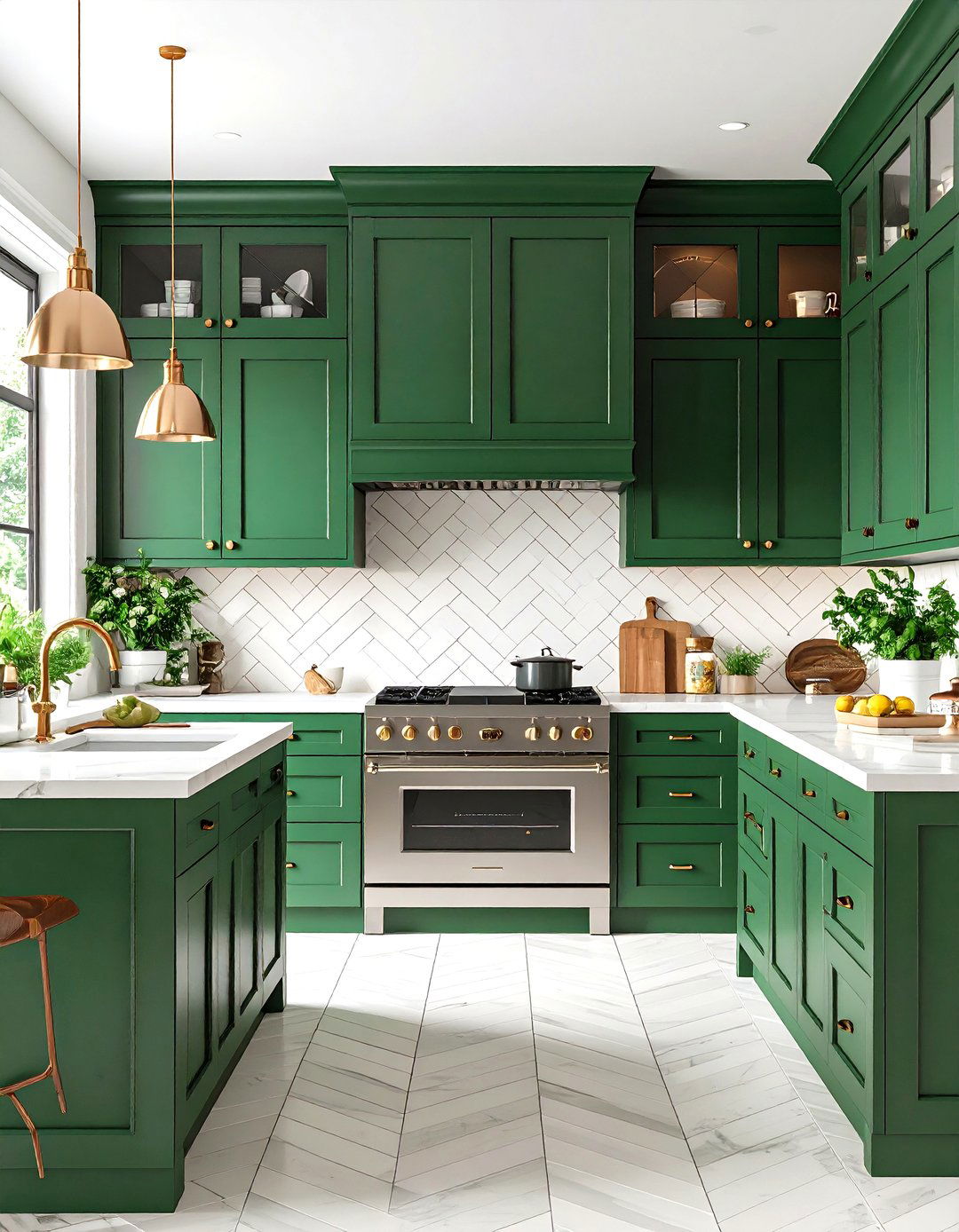
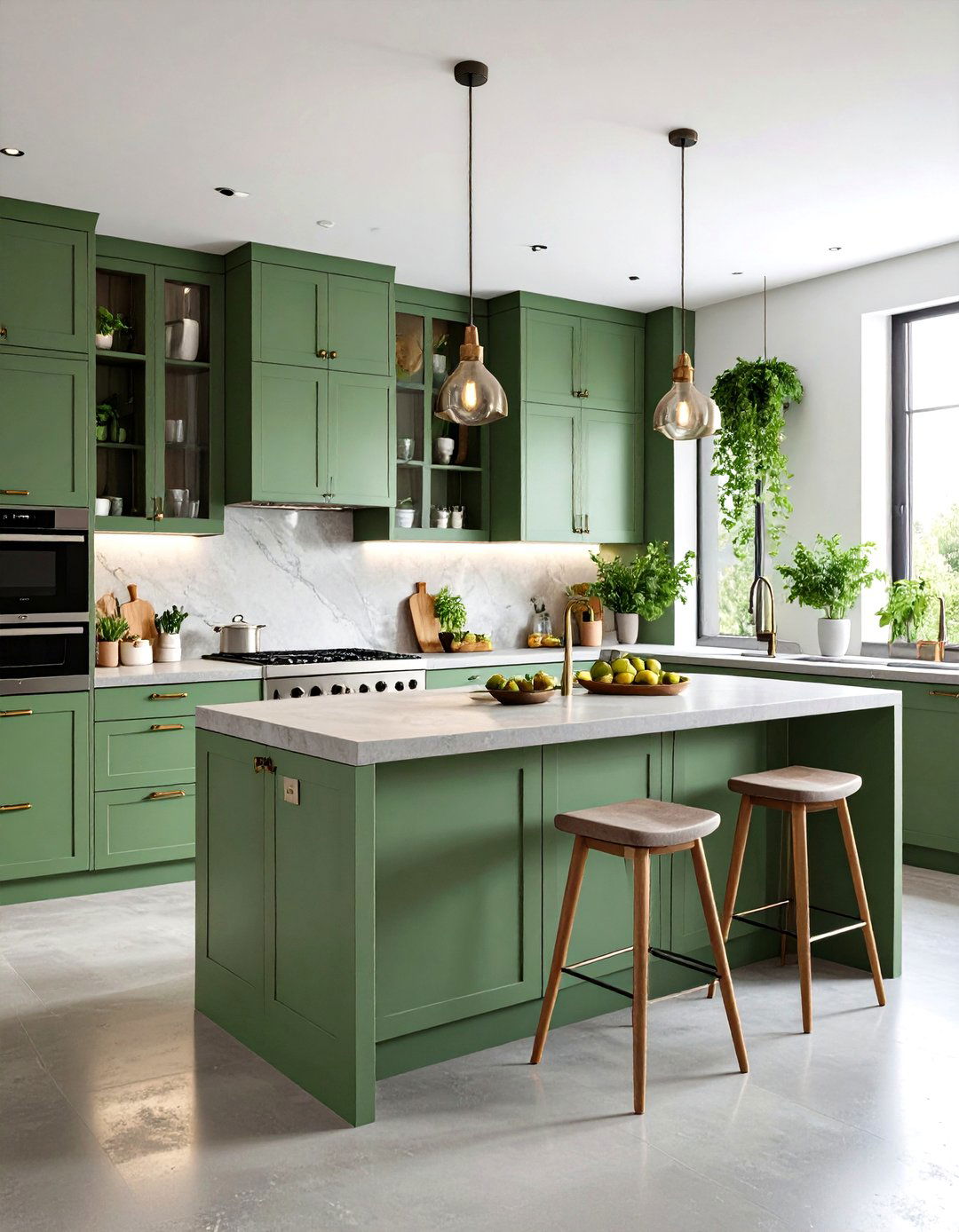
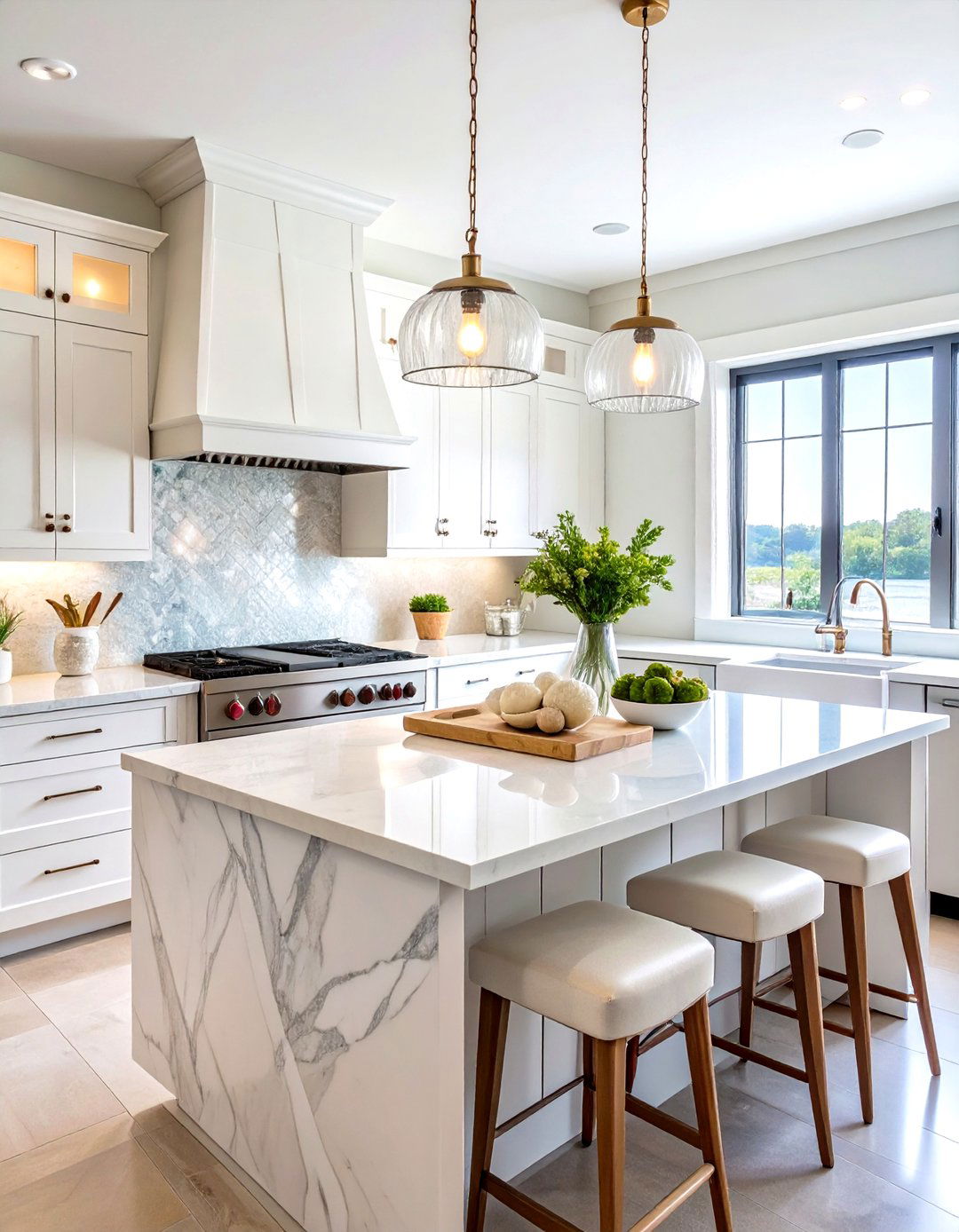
Leave a Reply